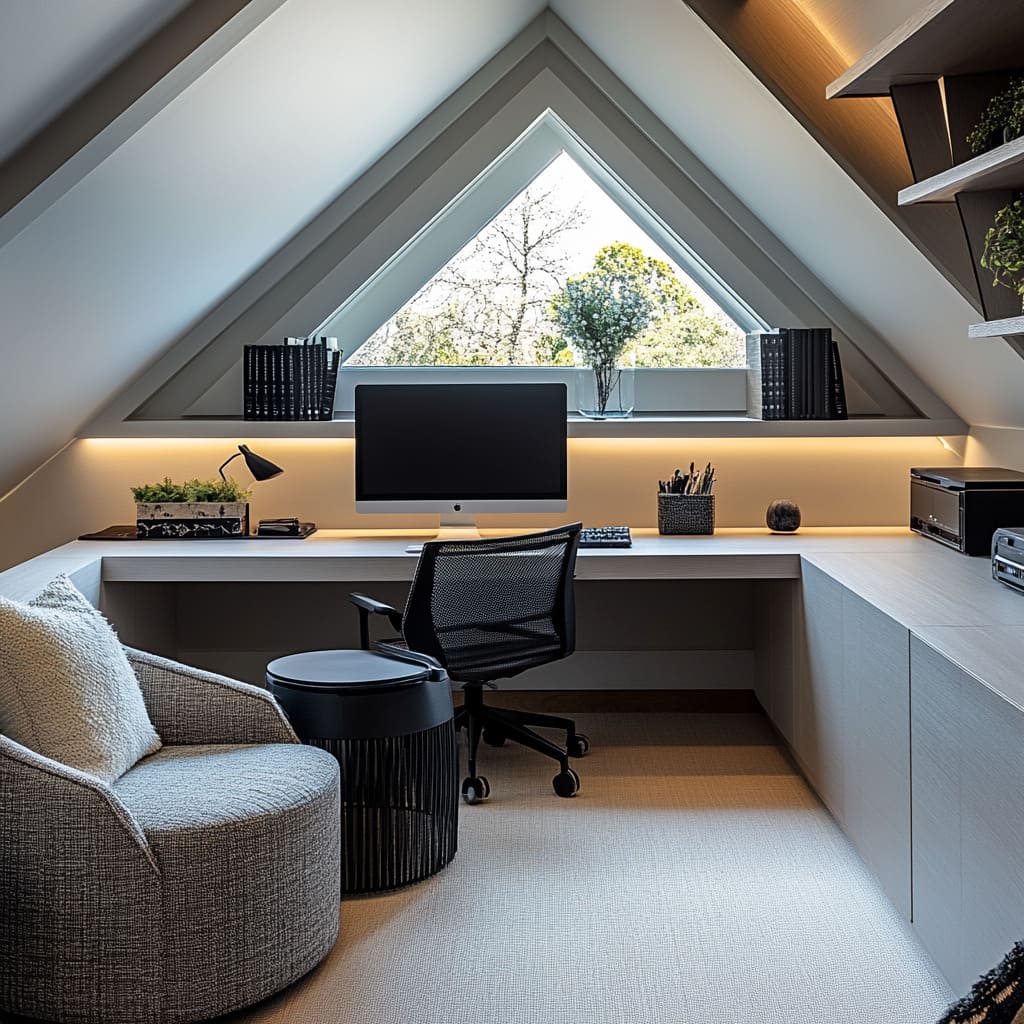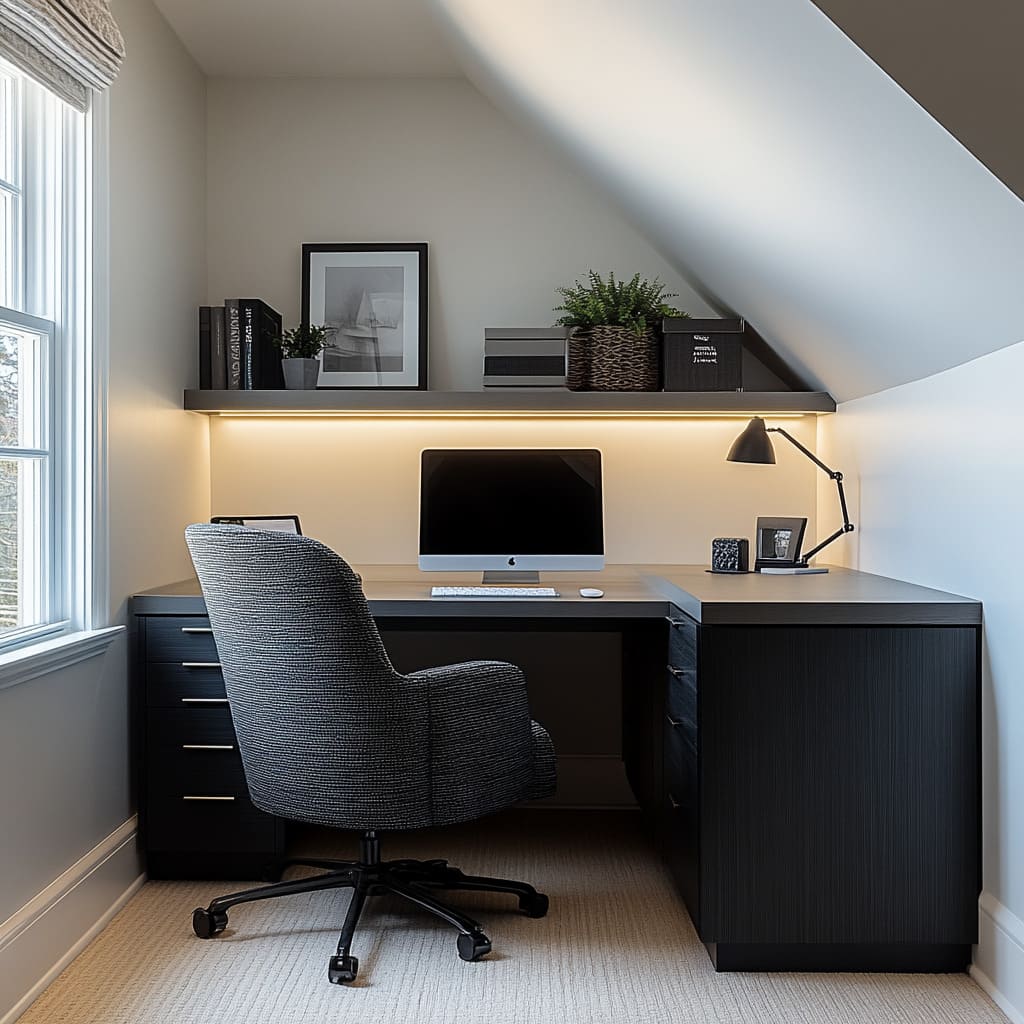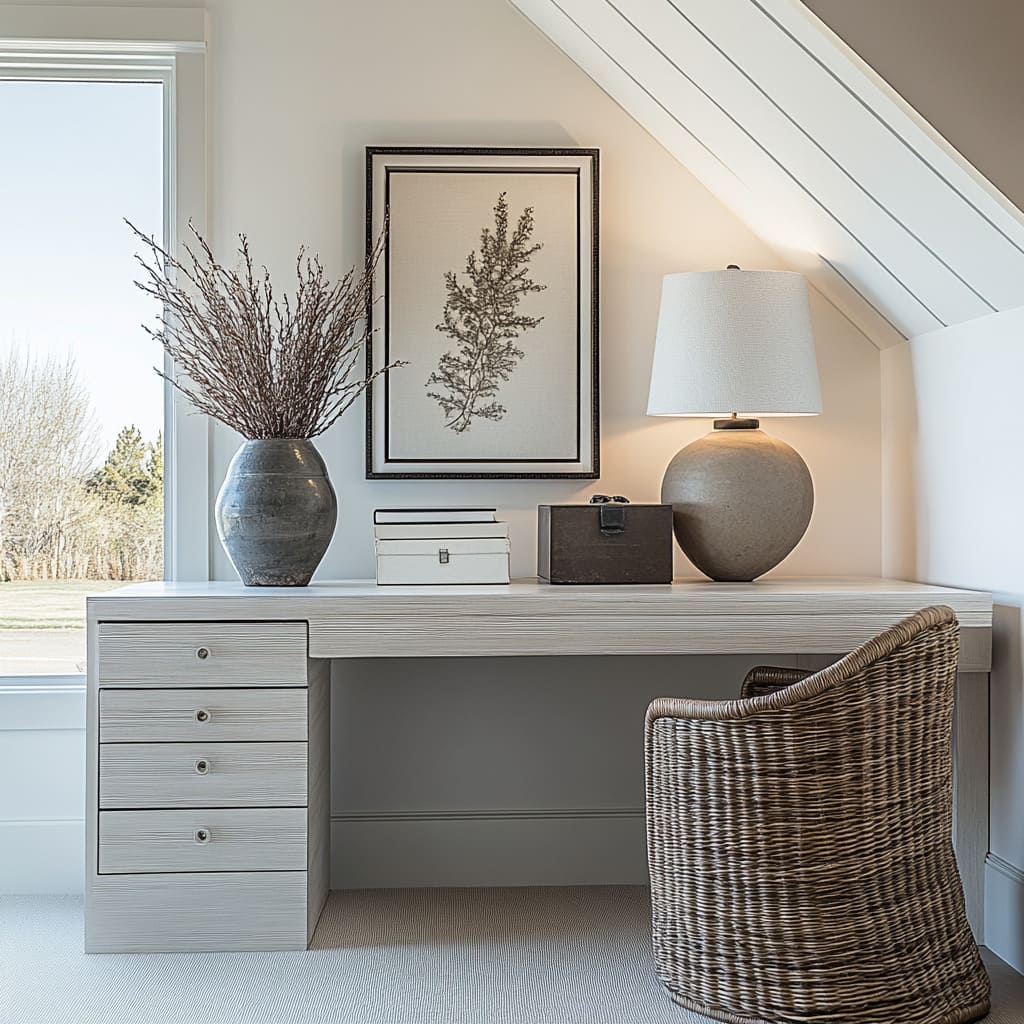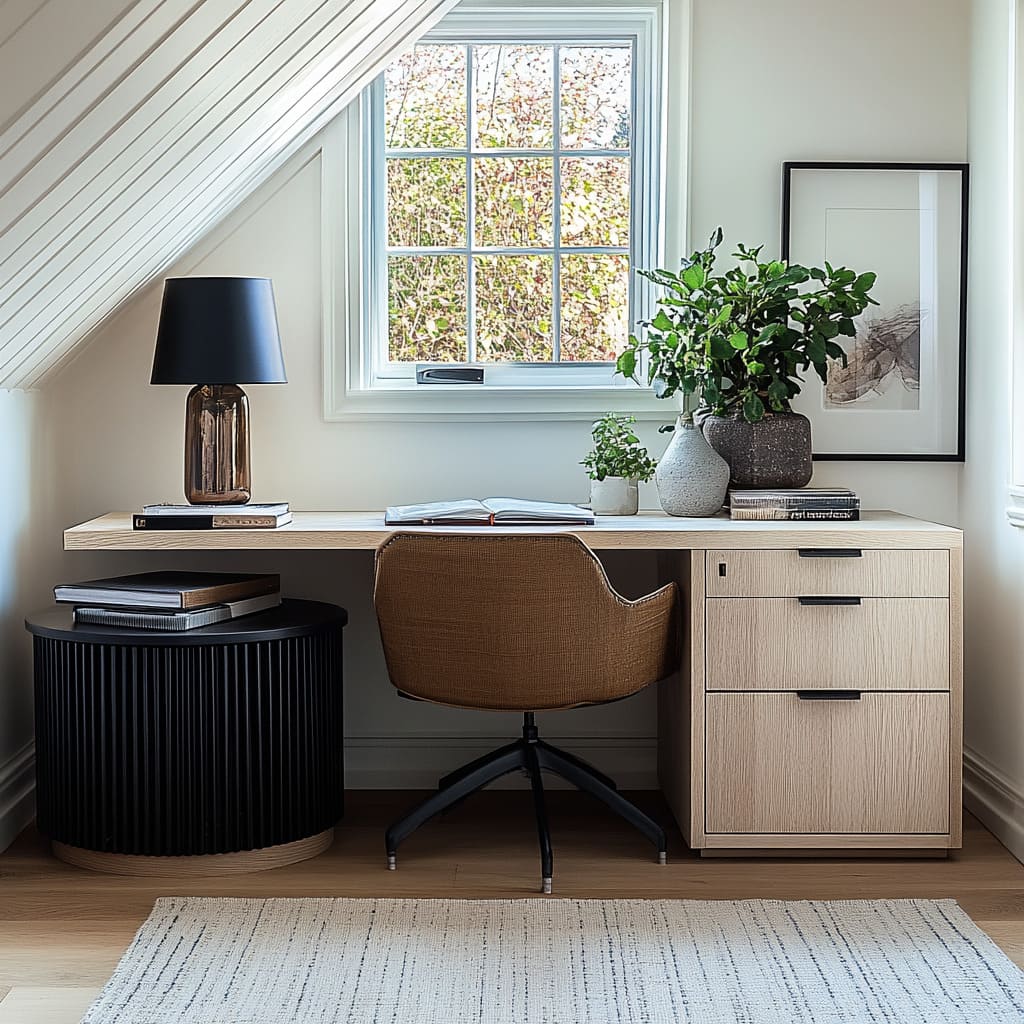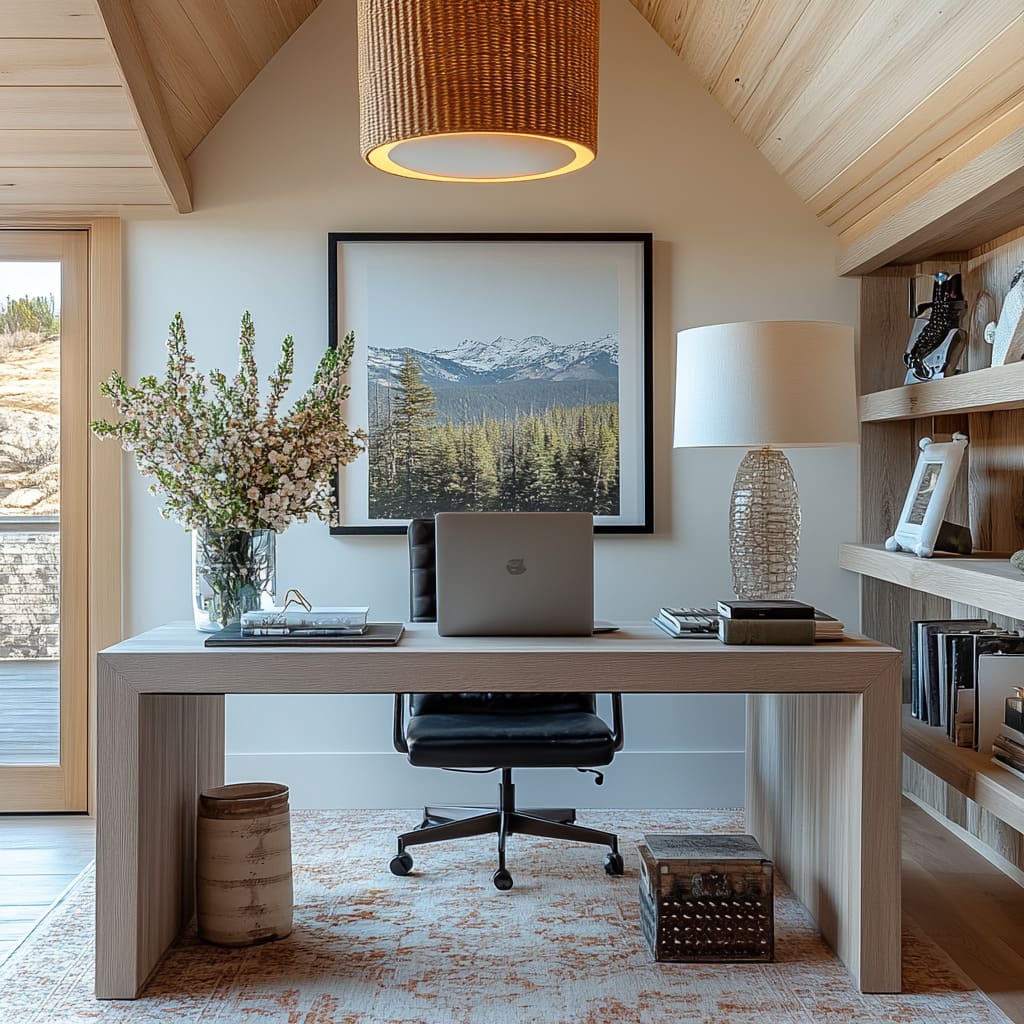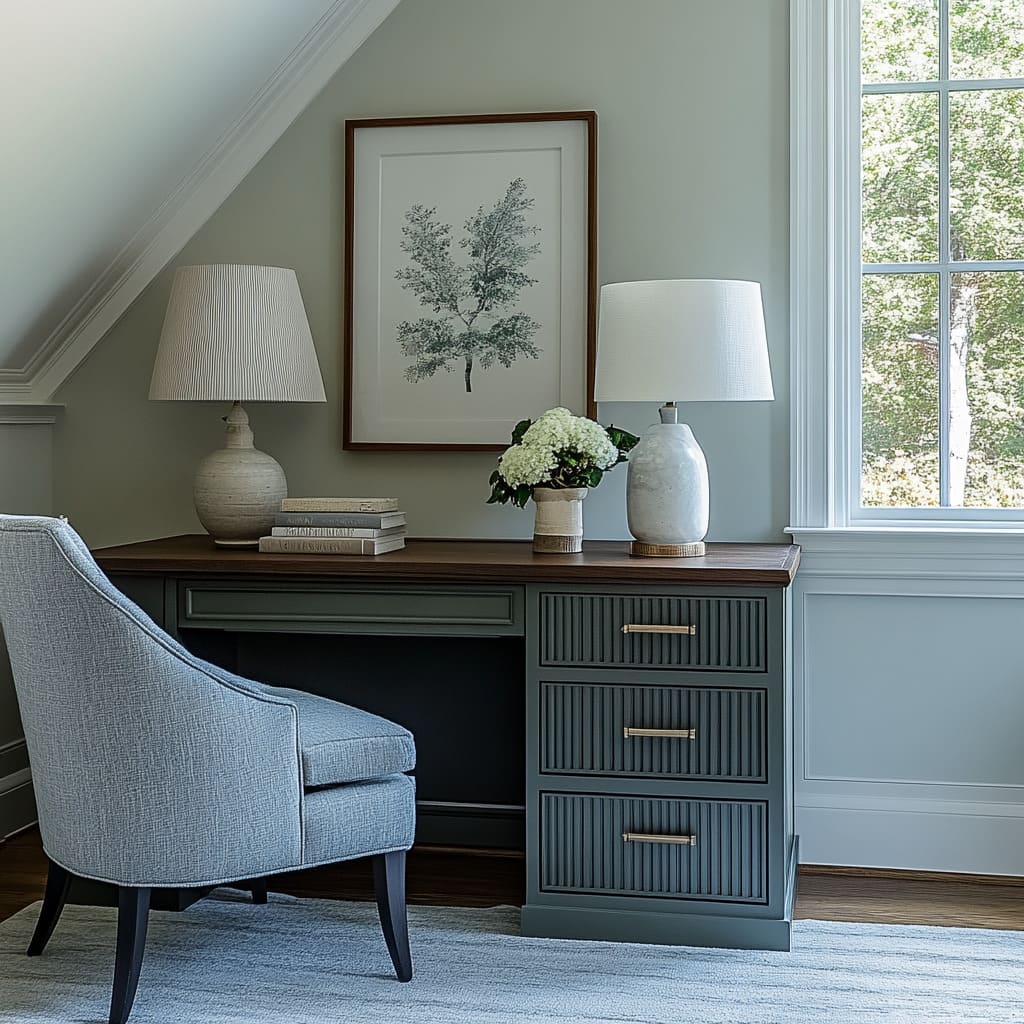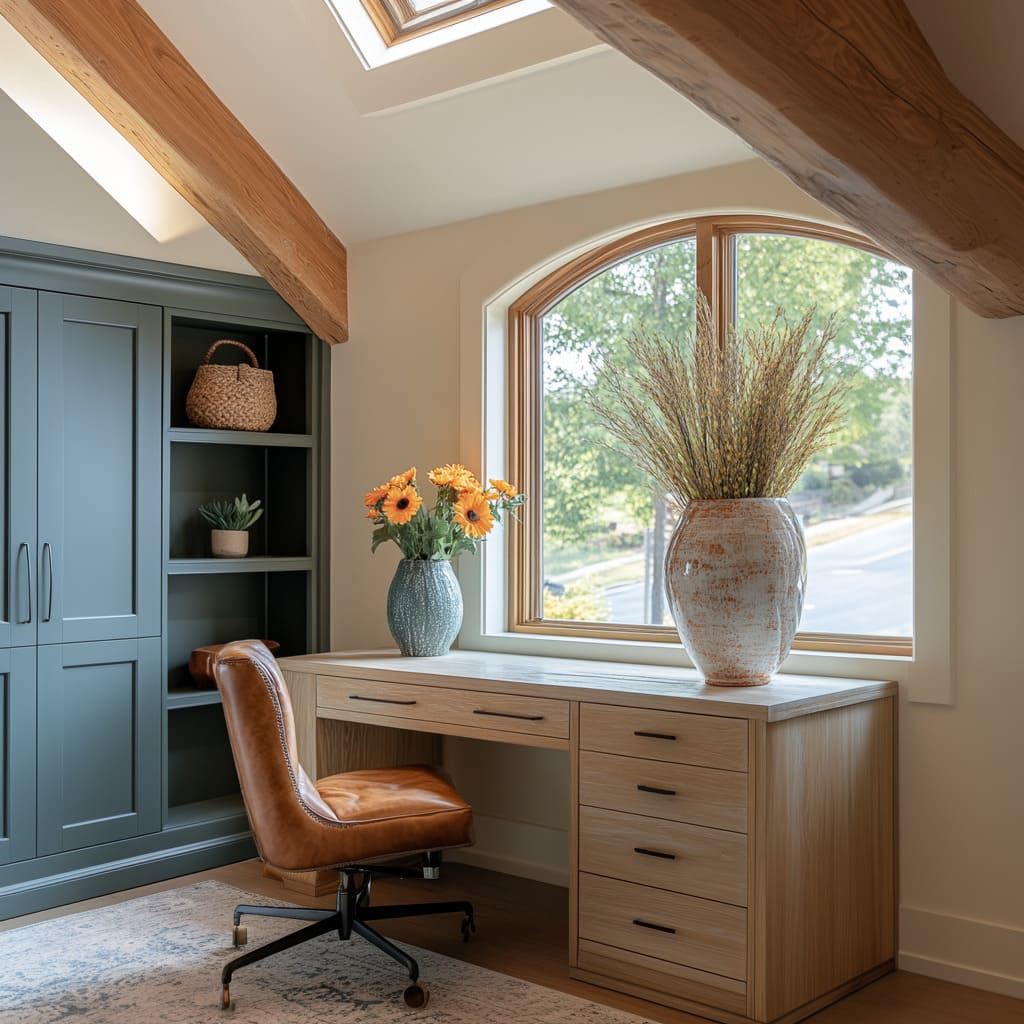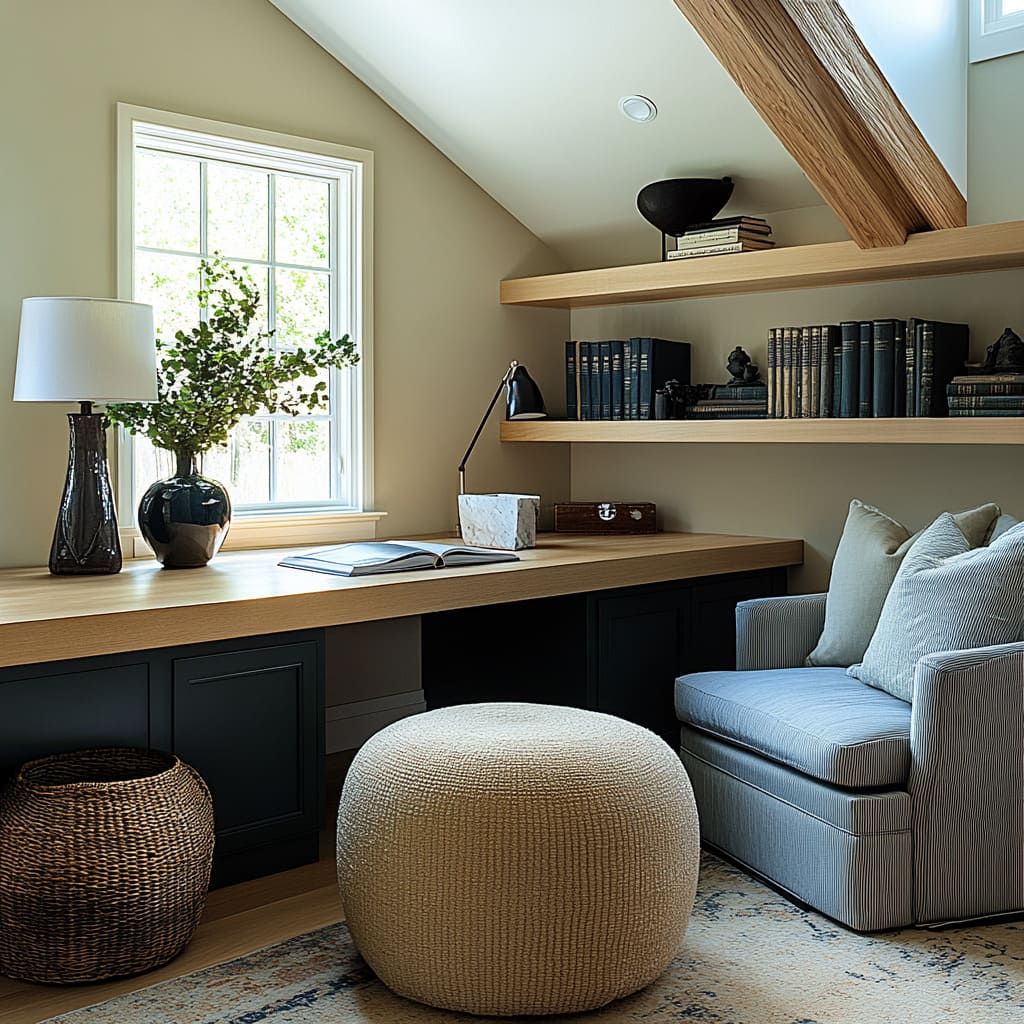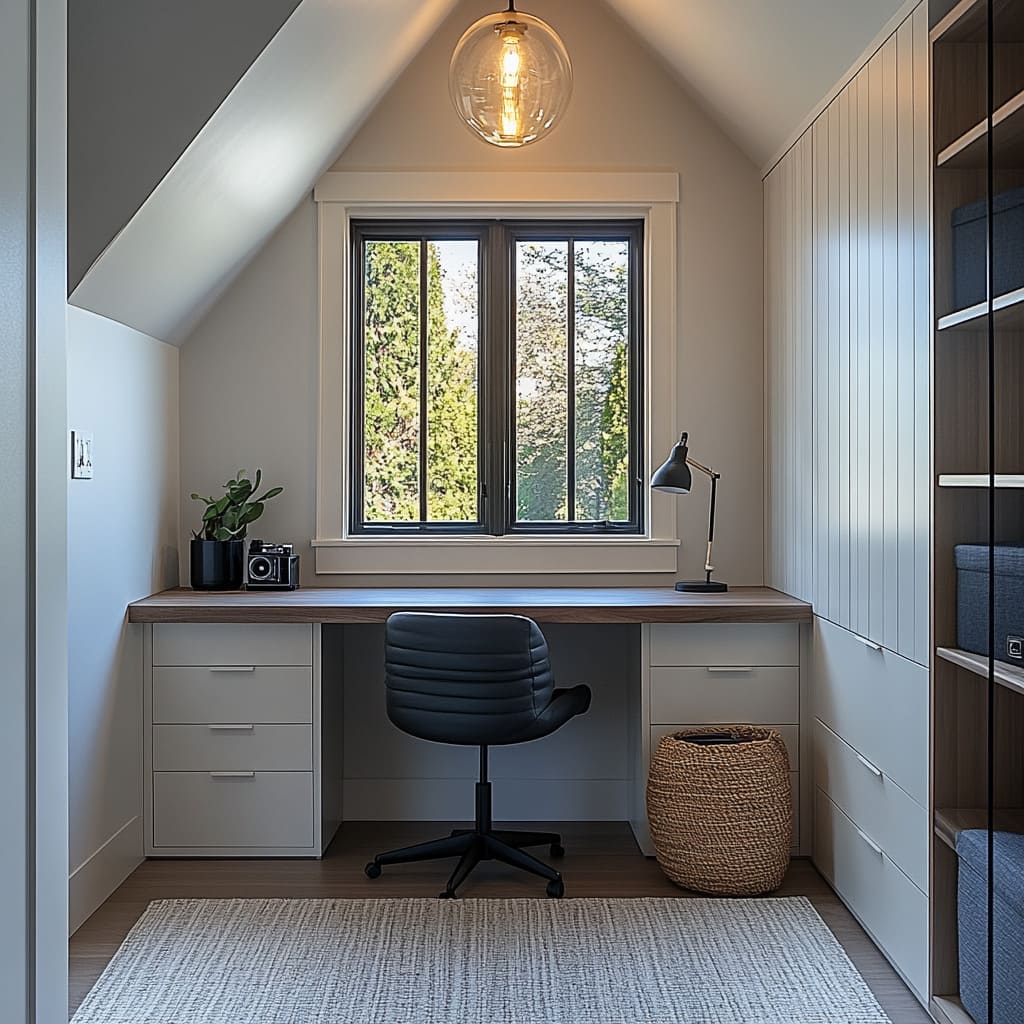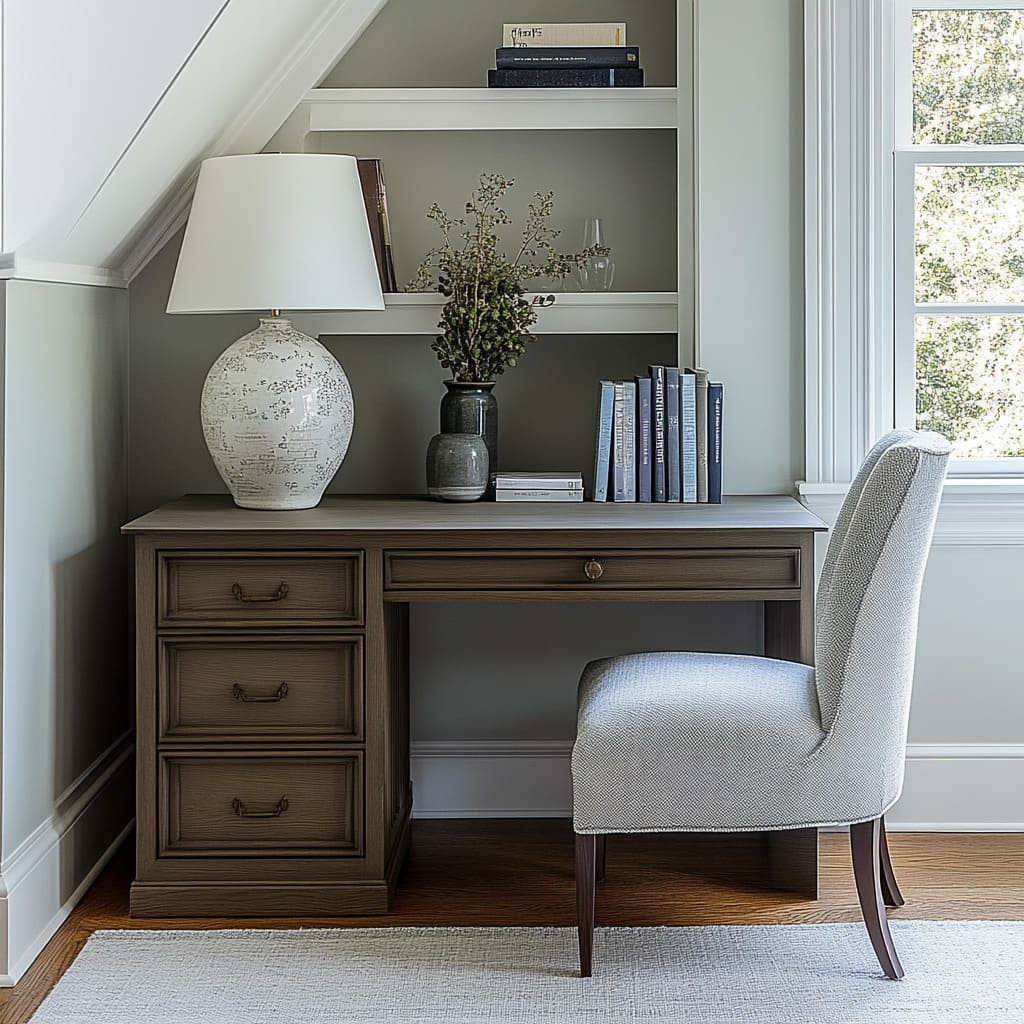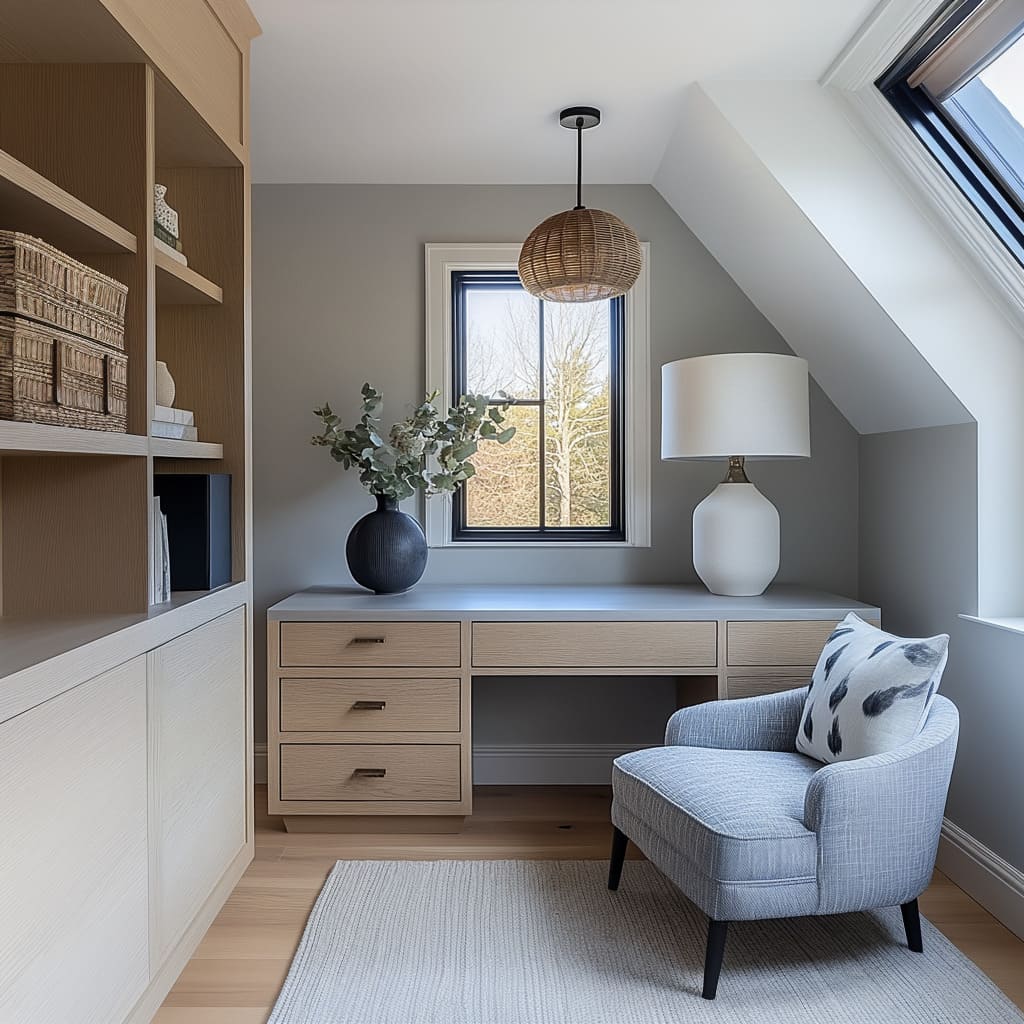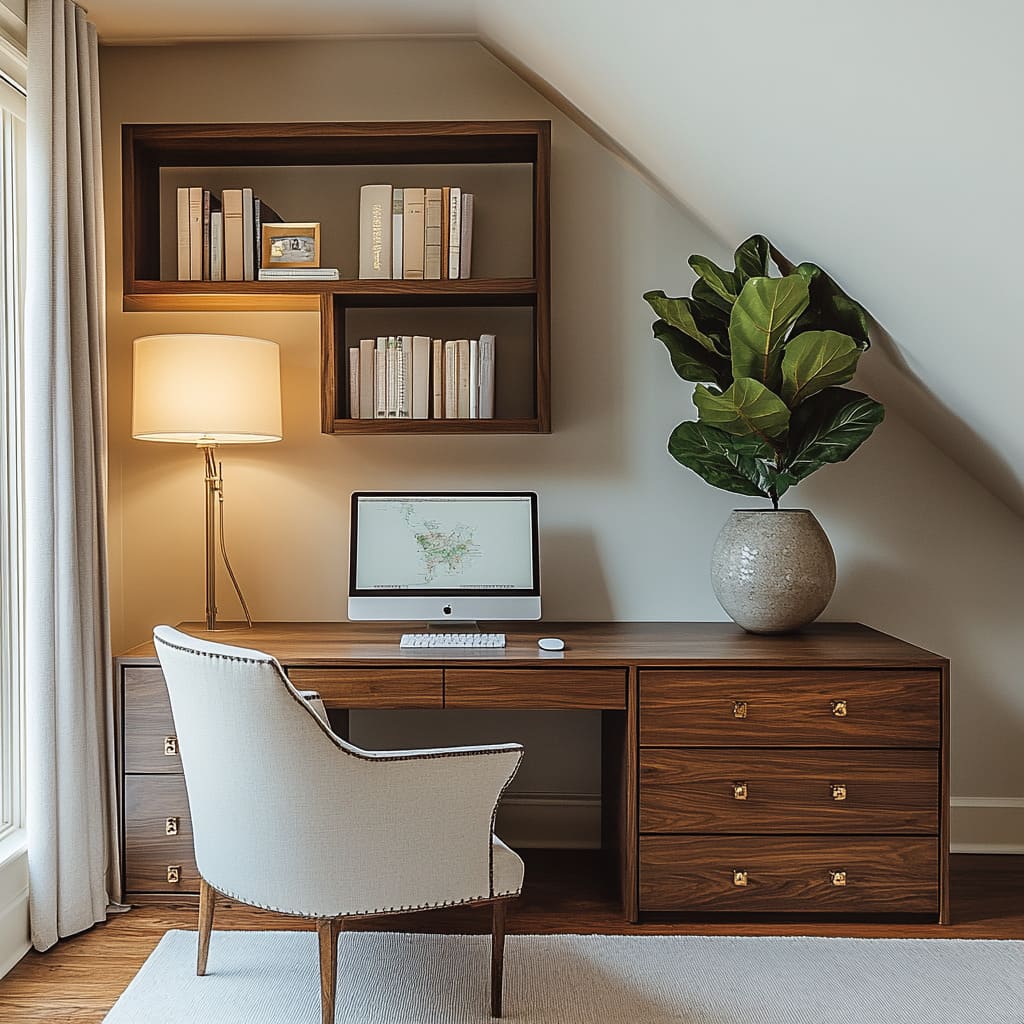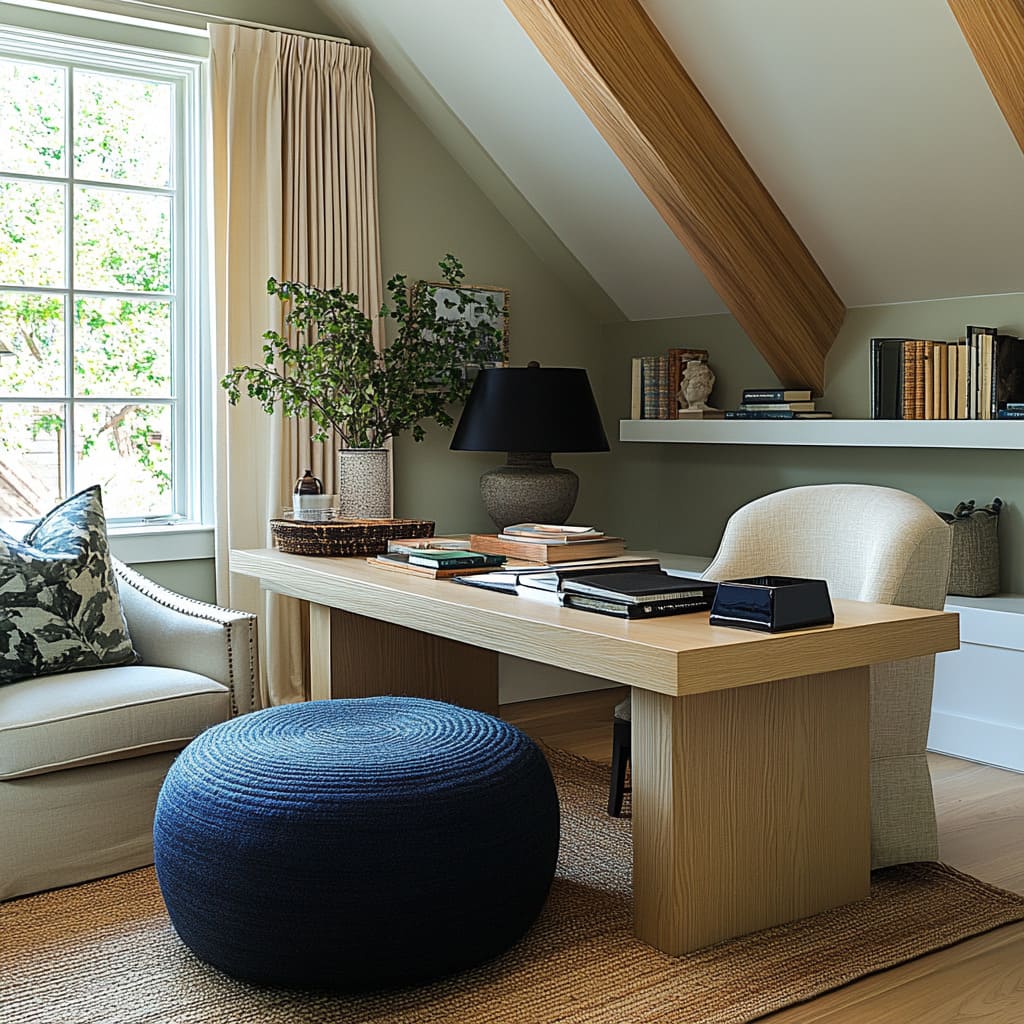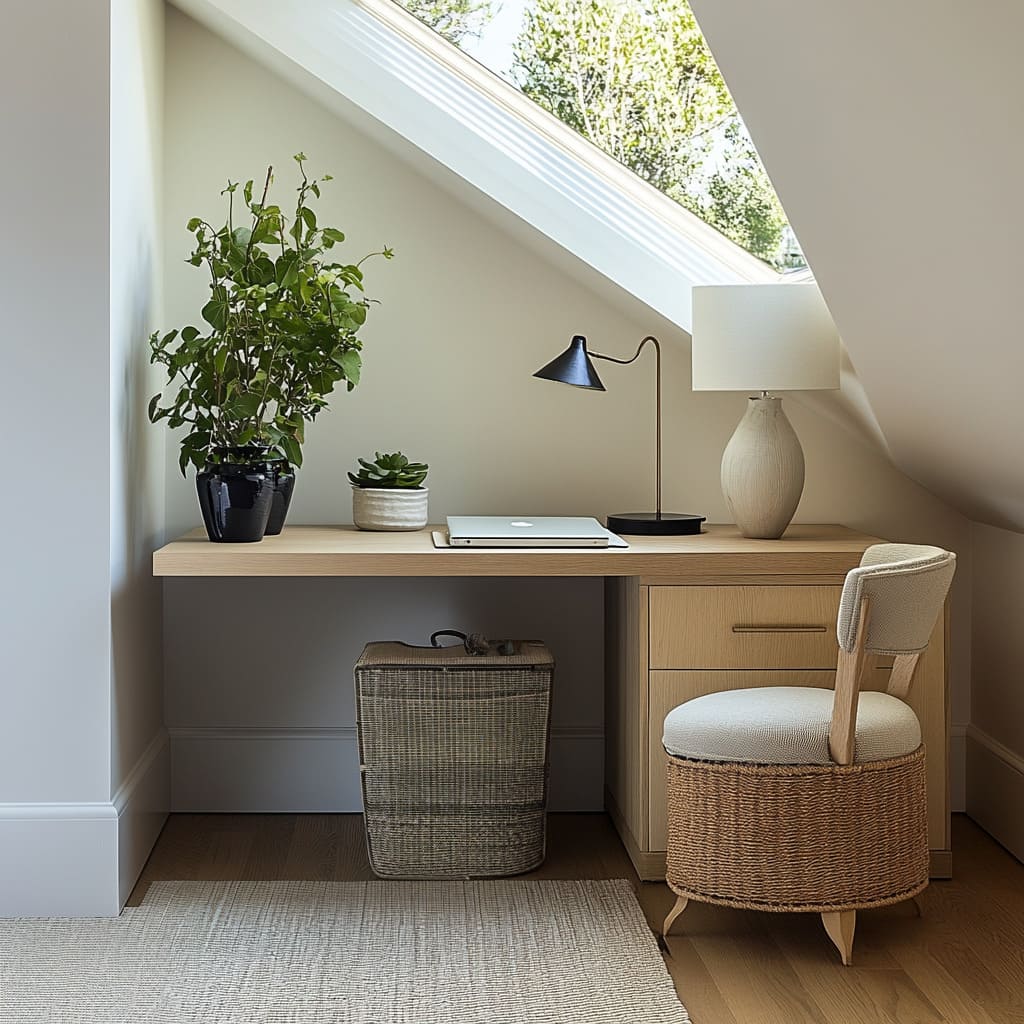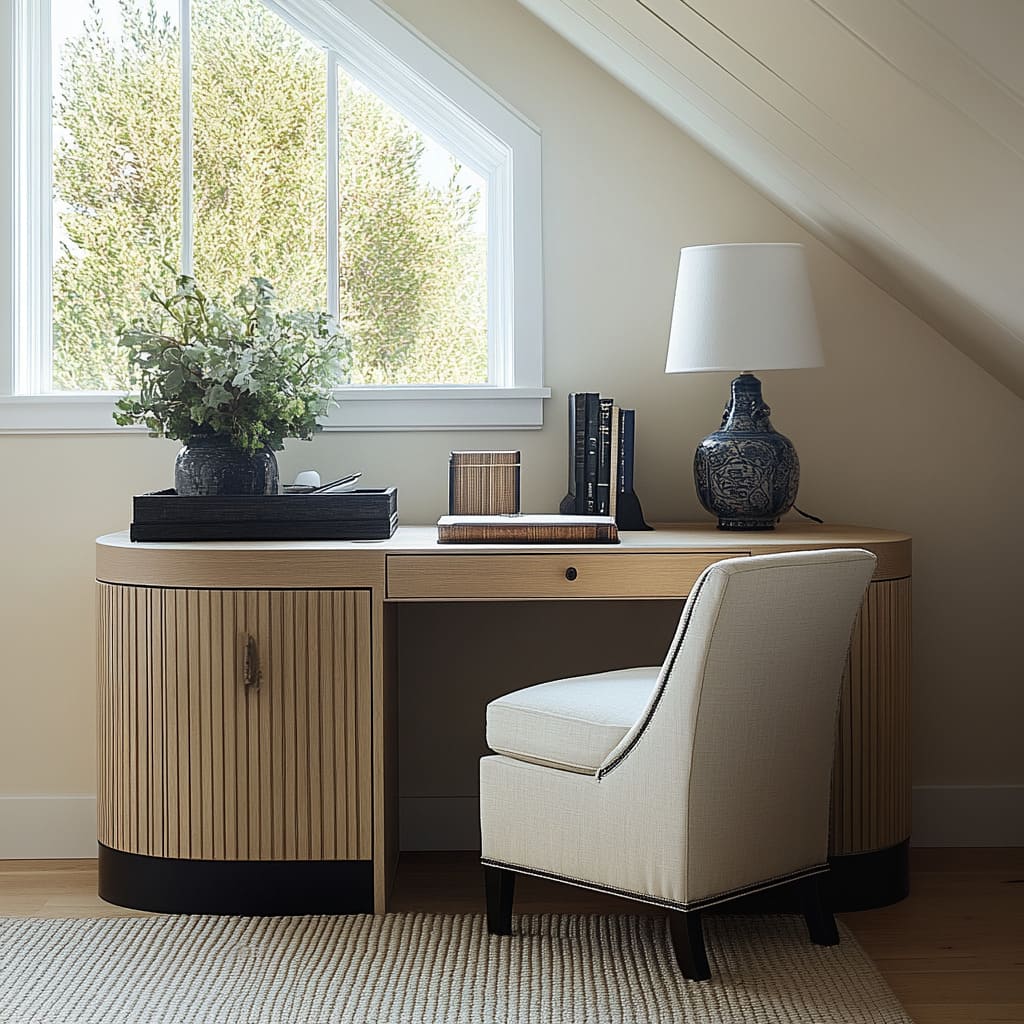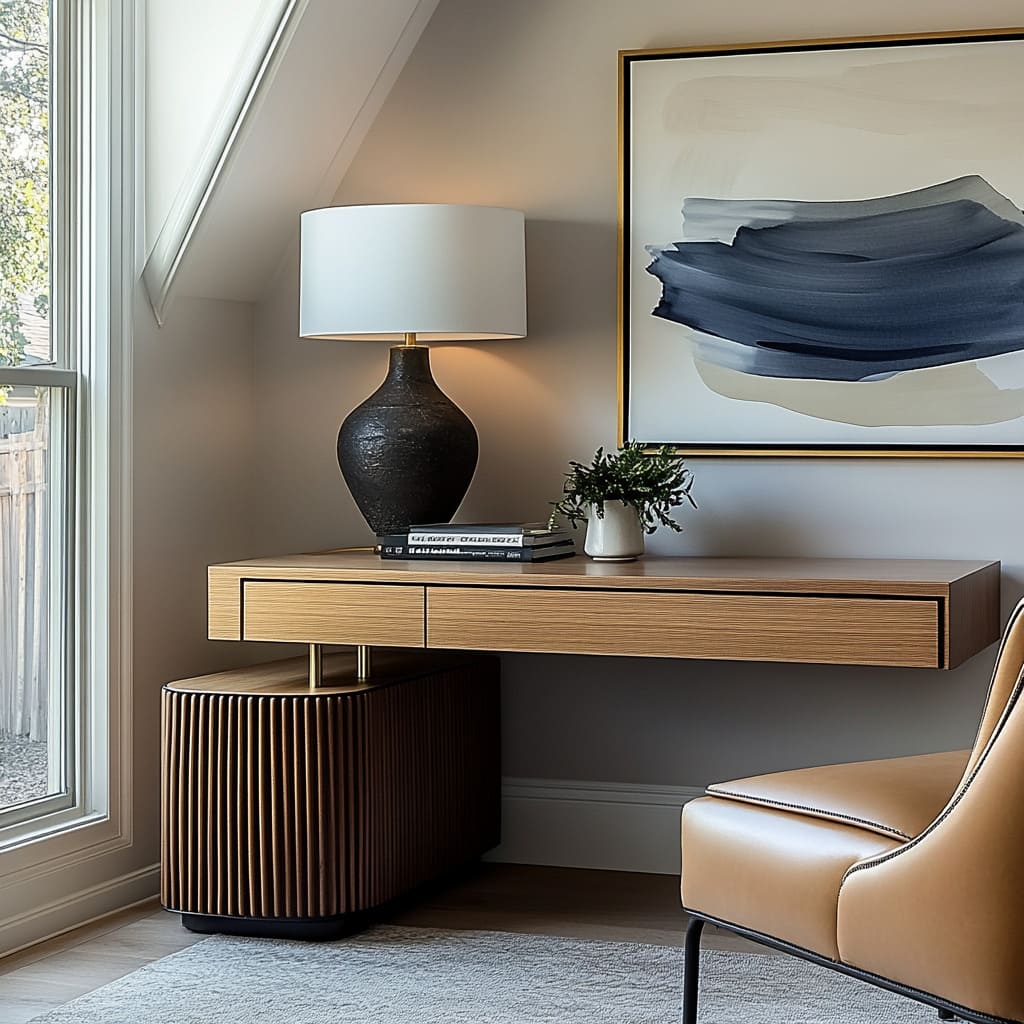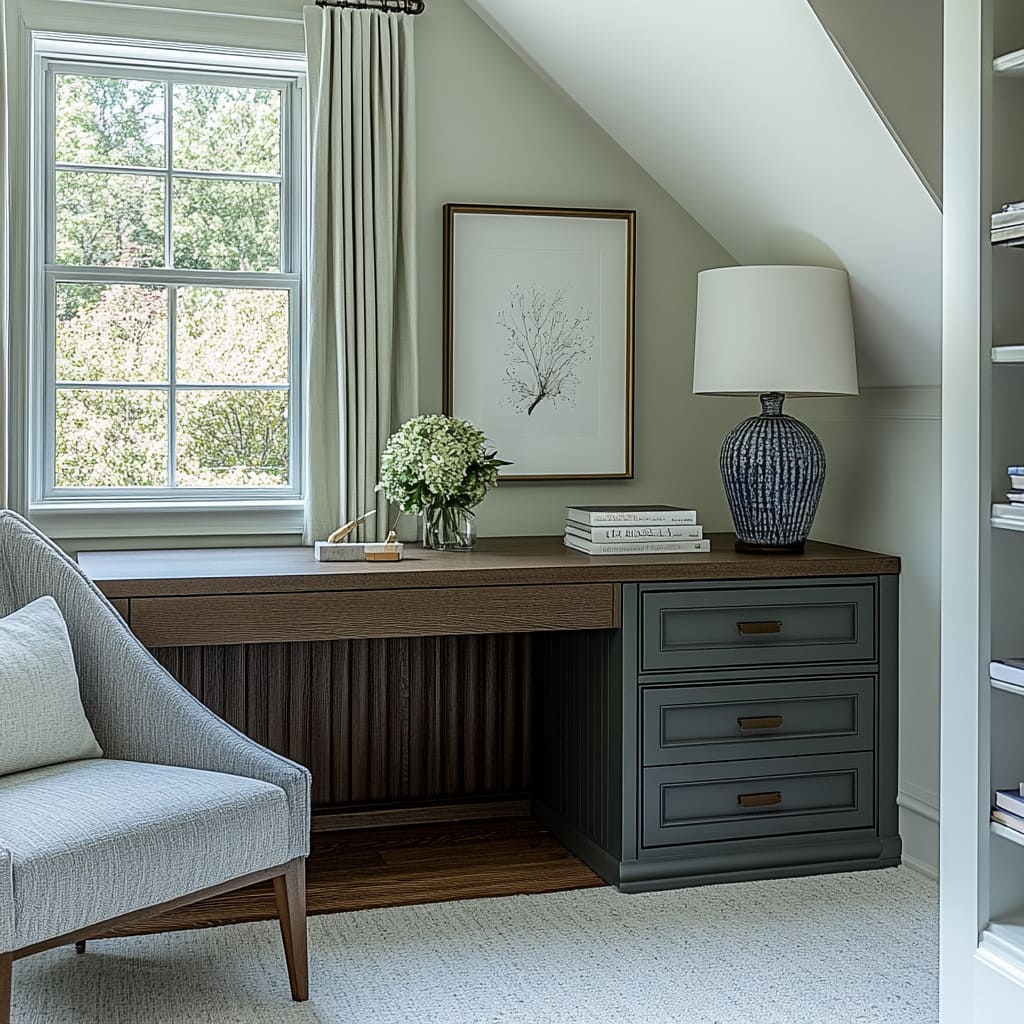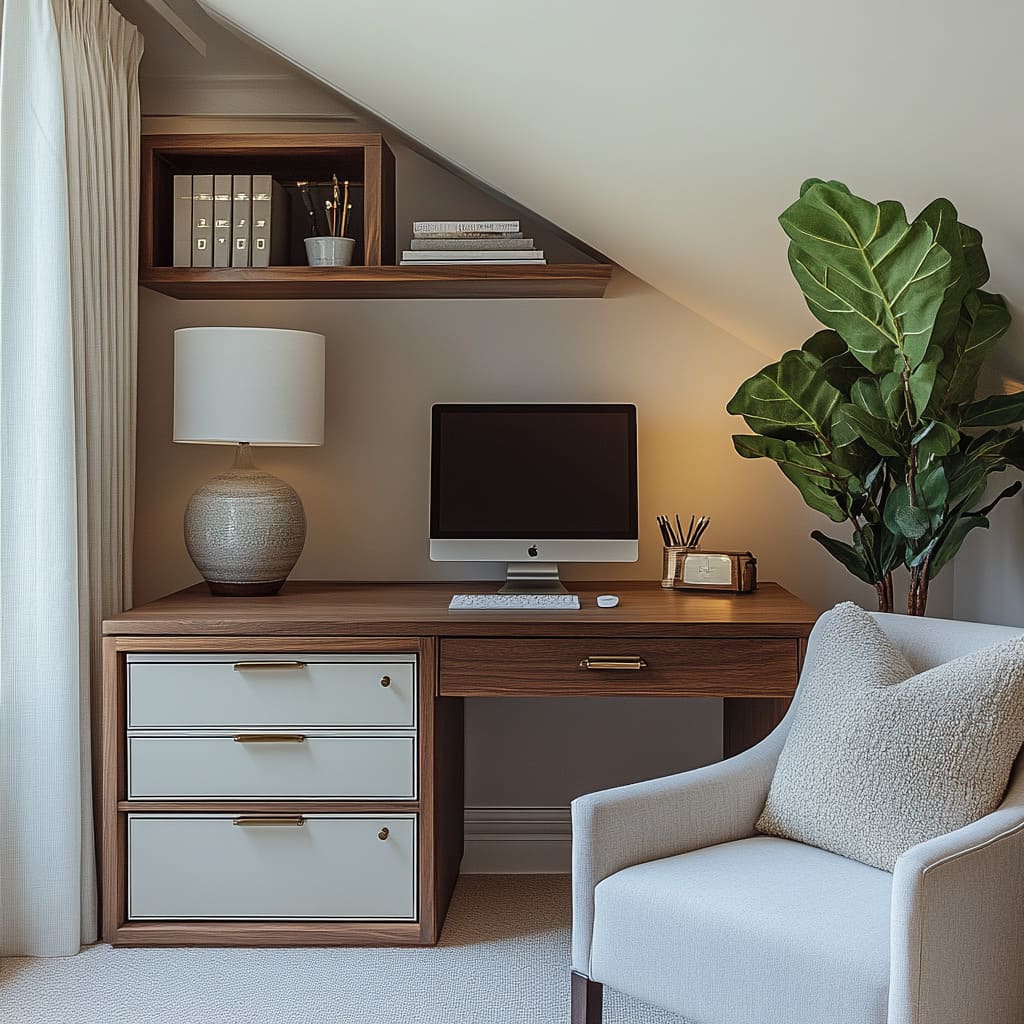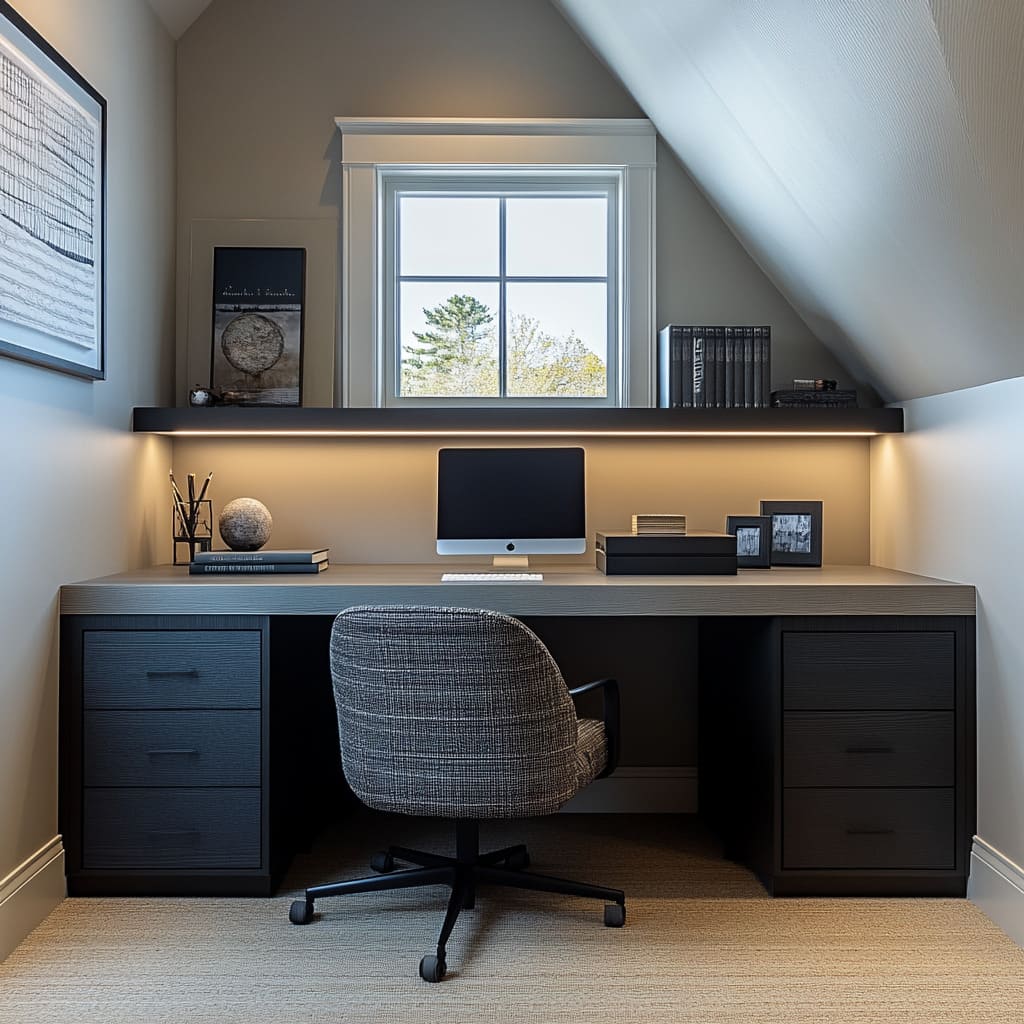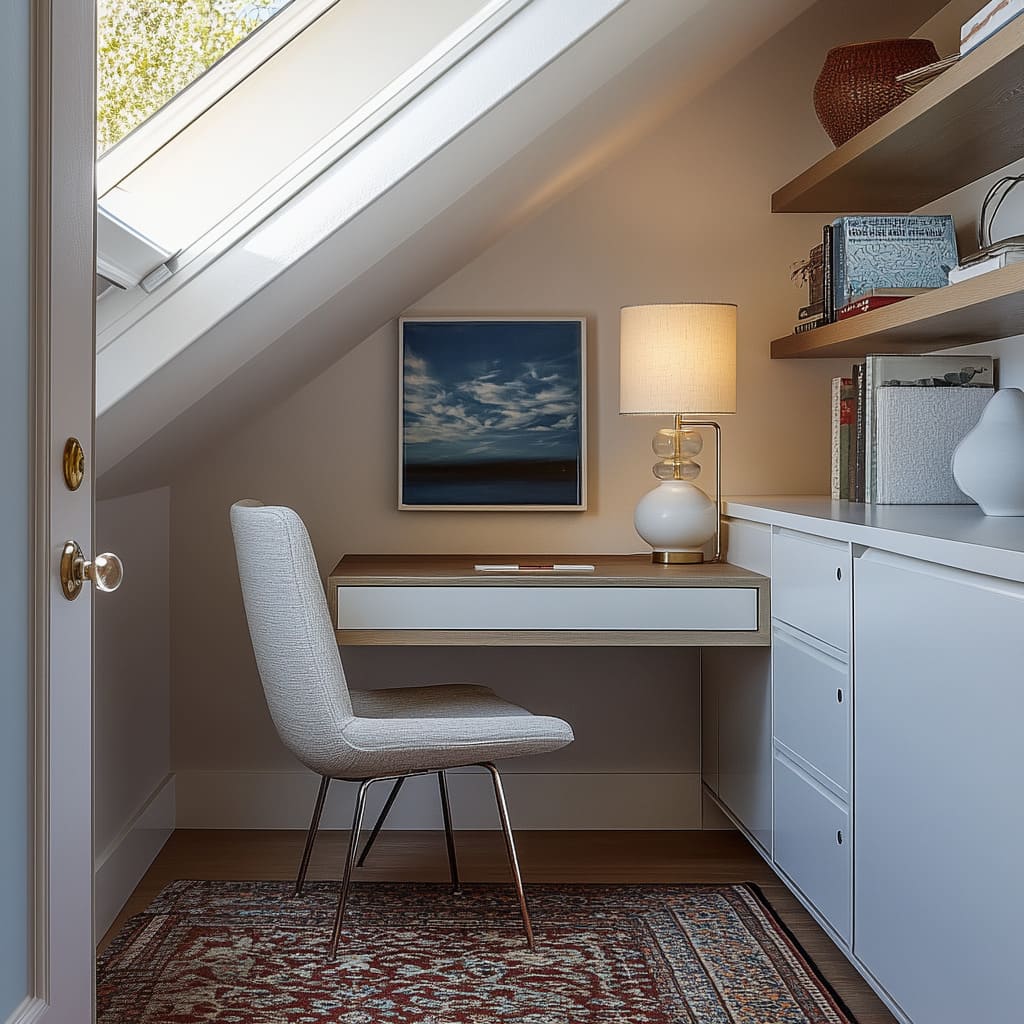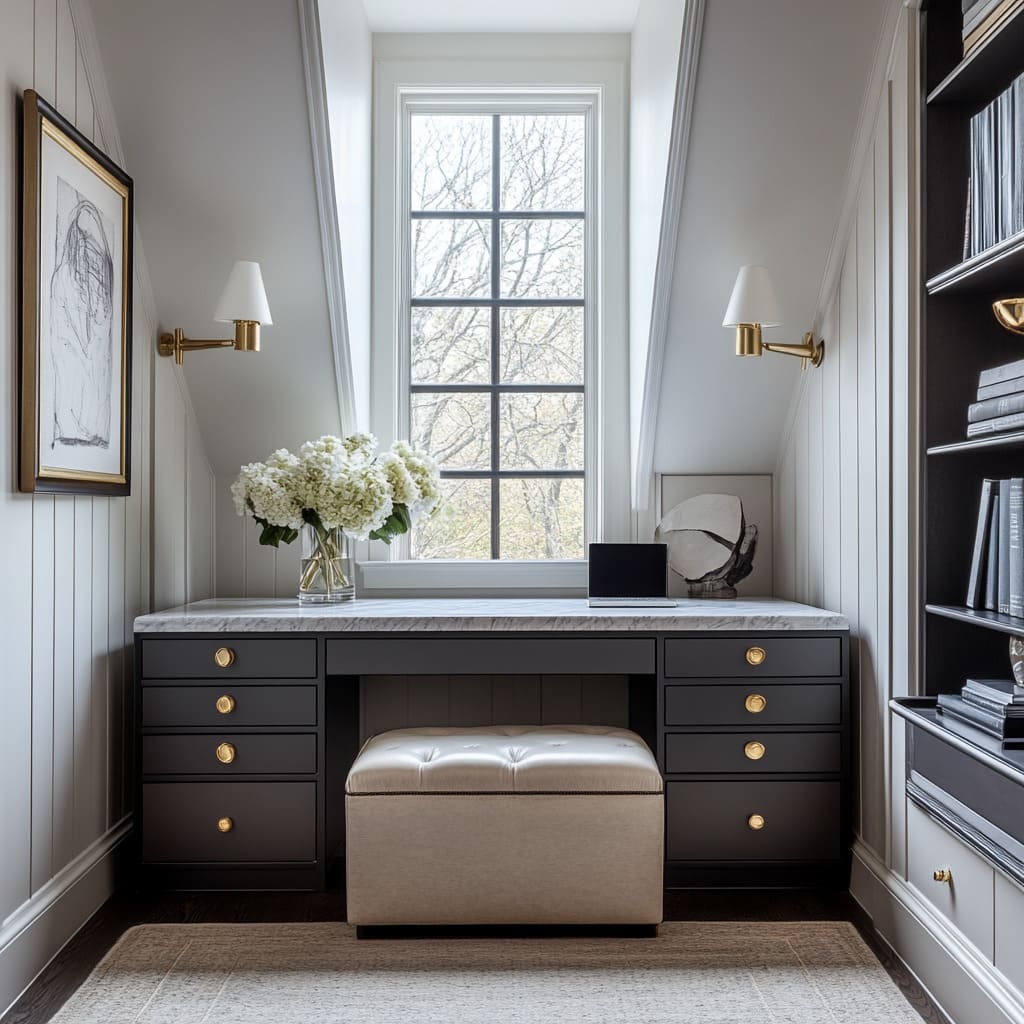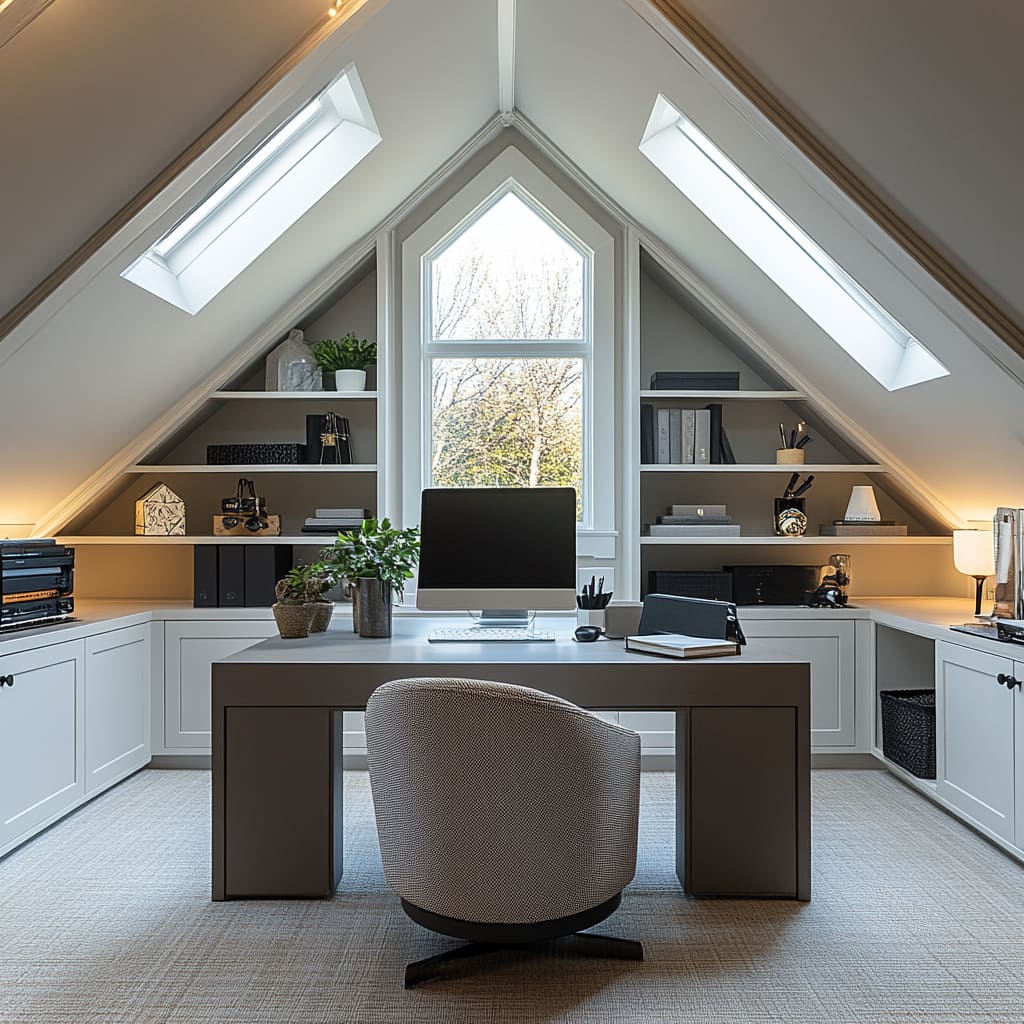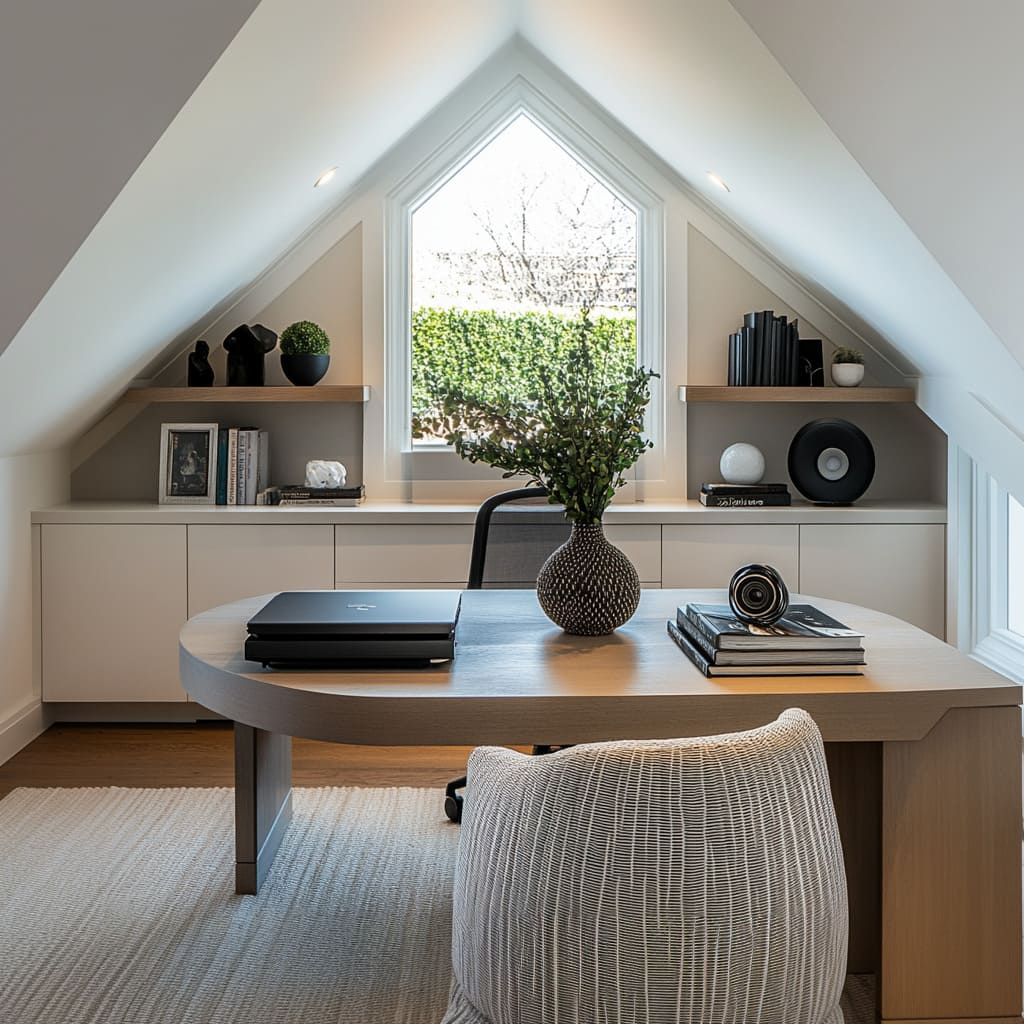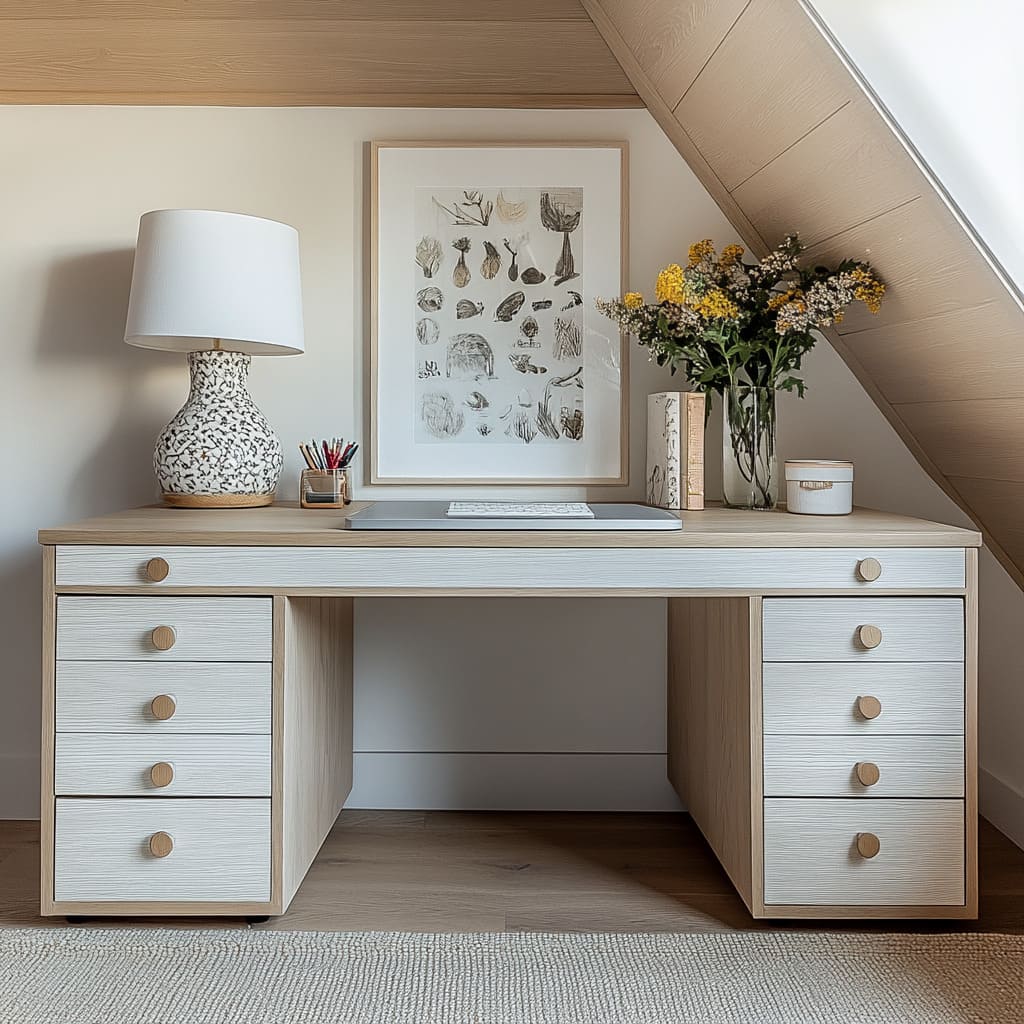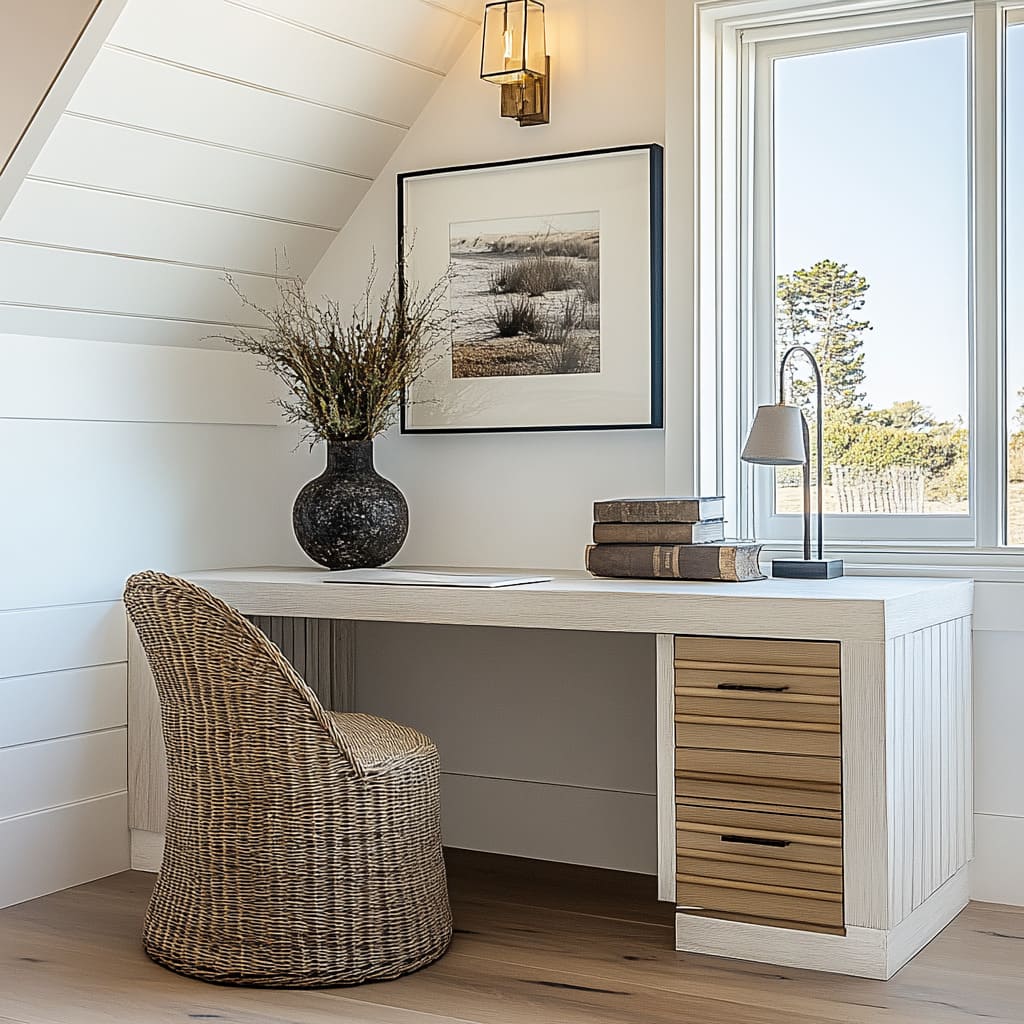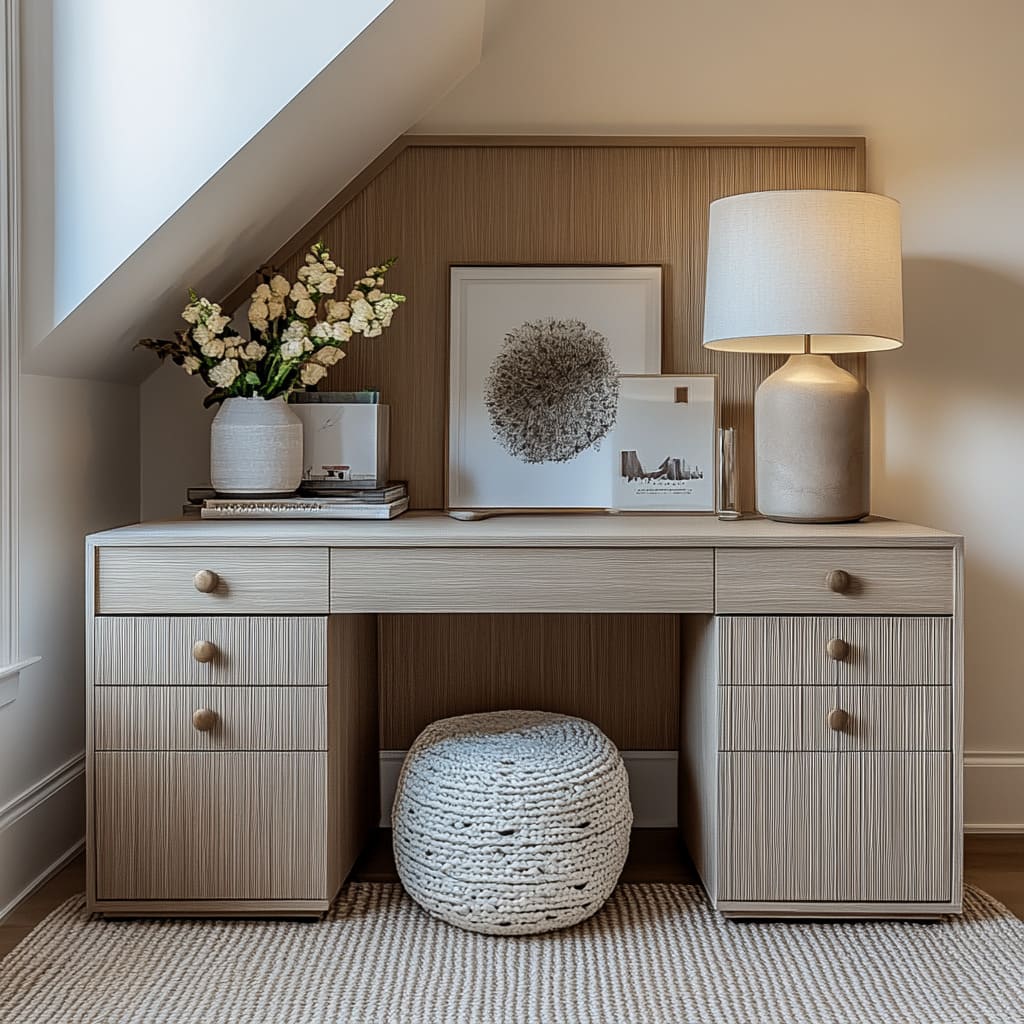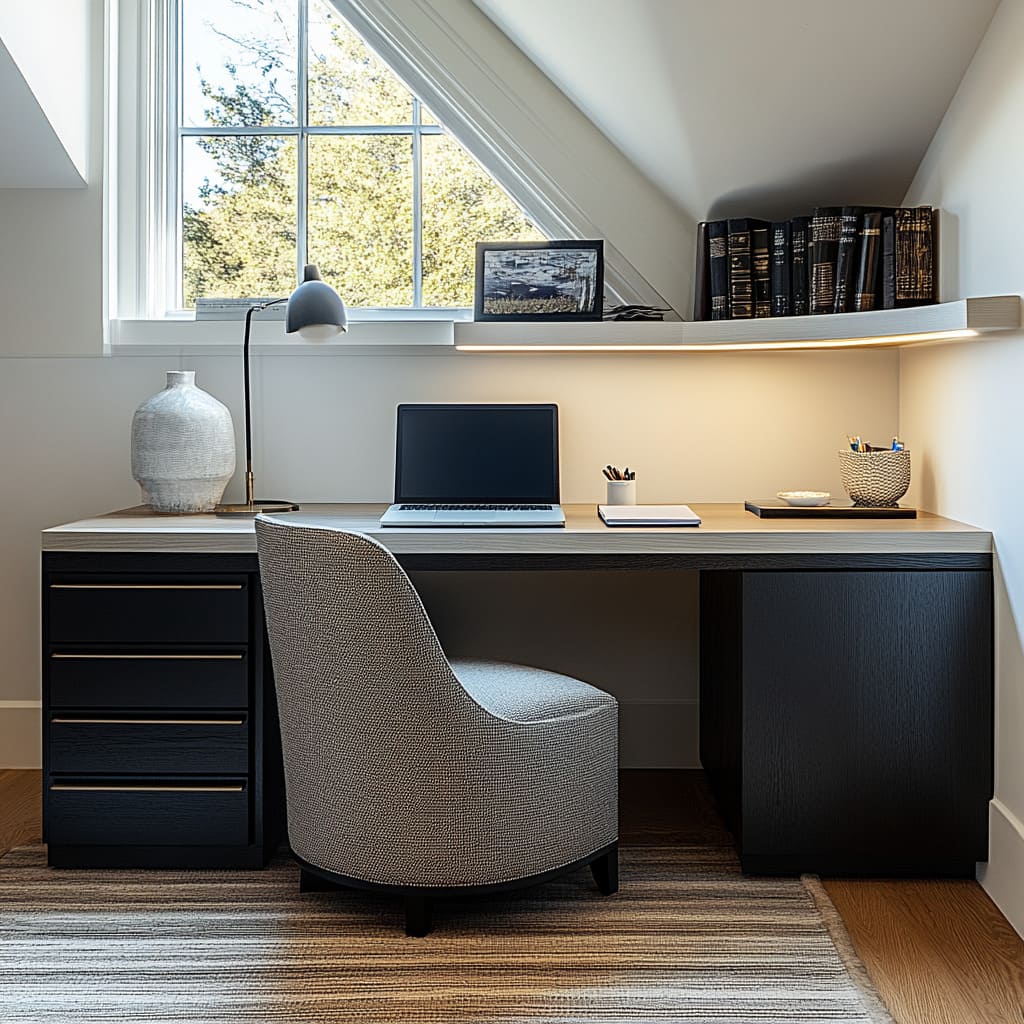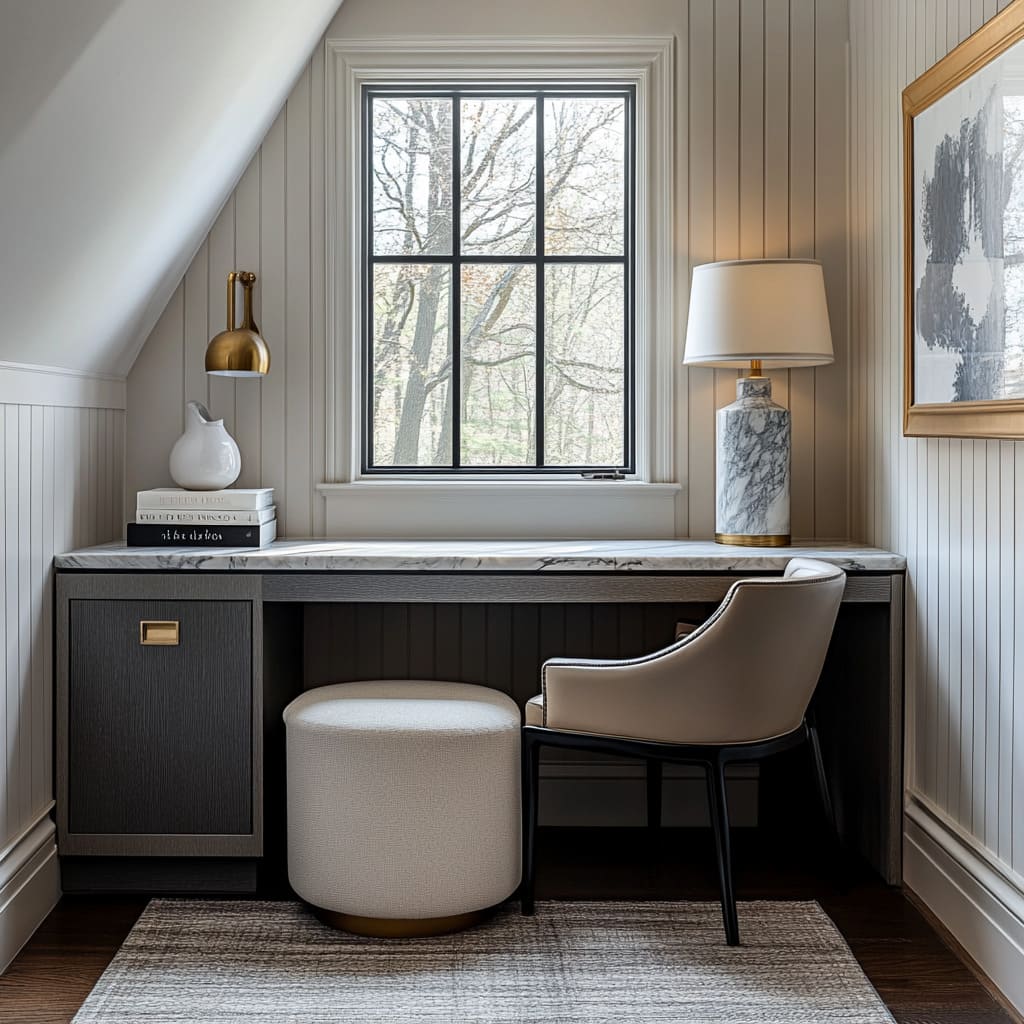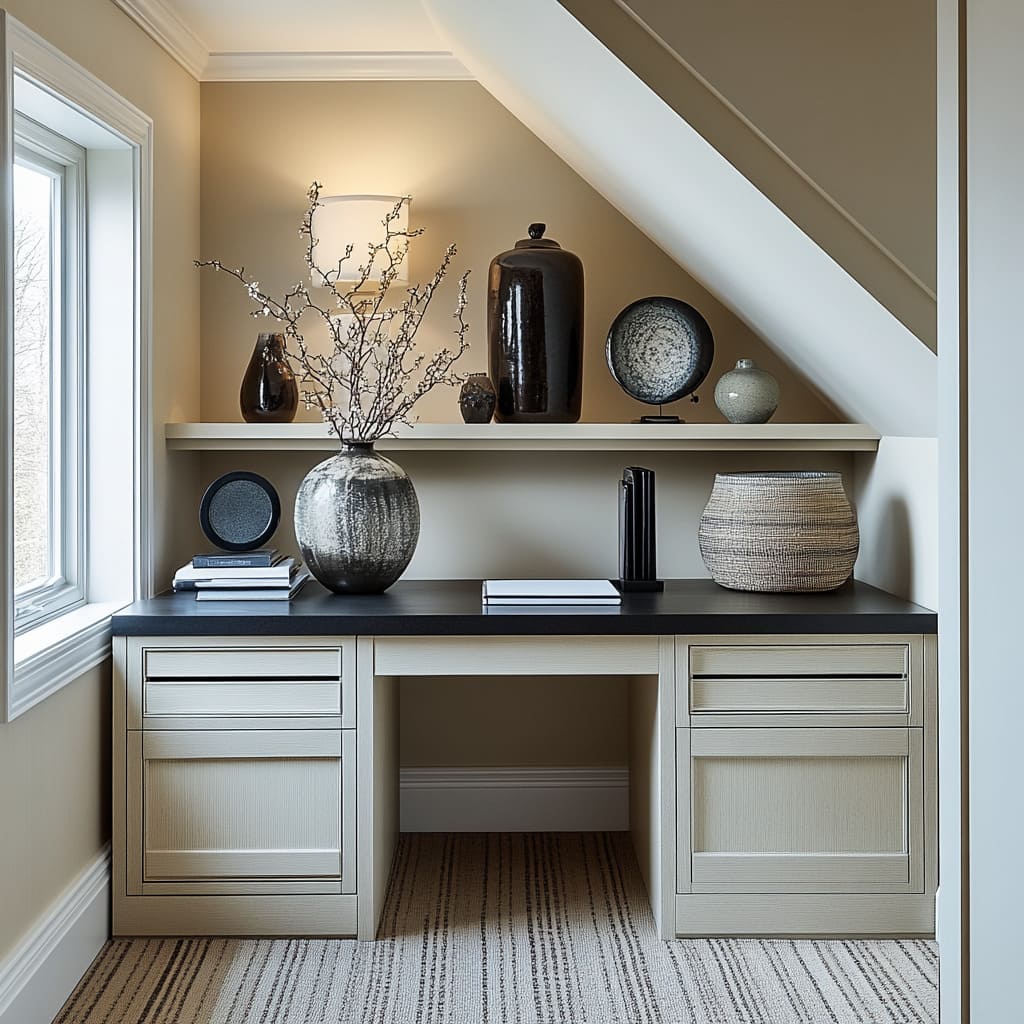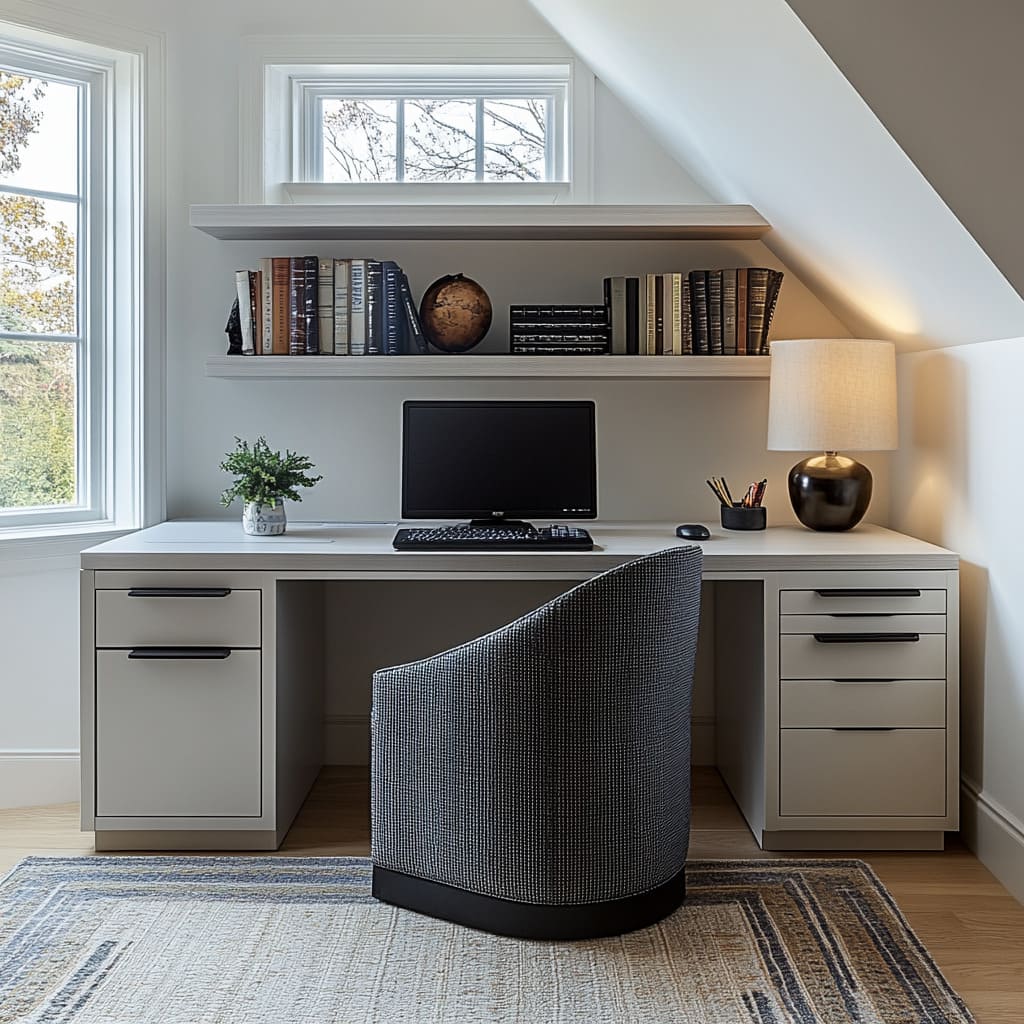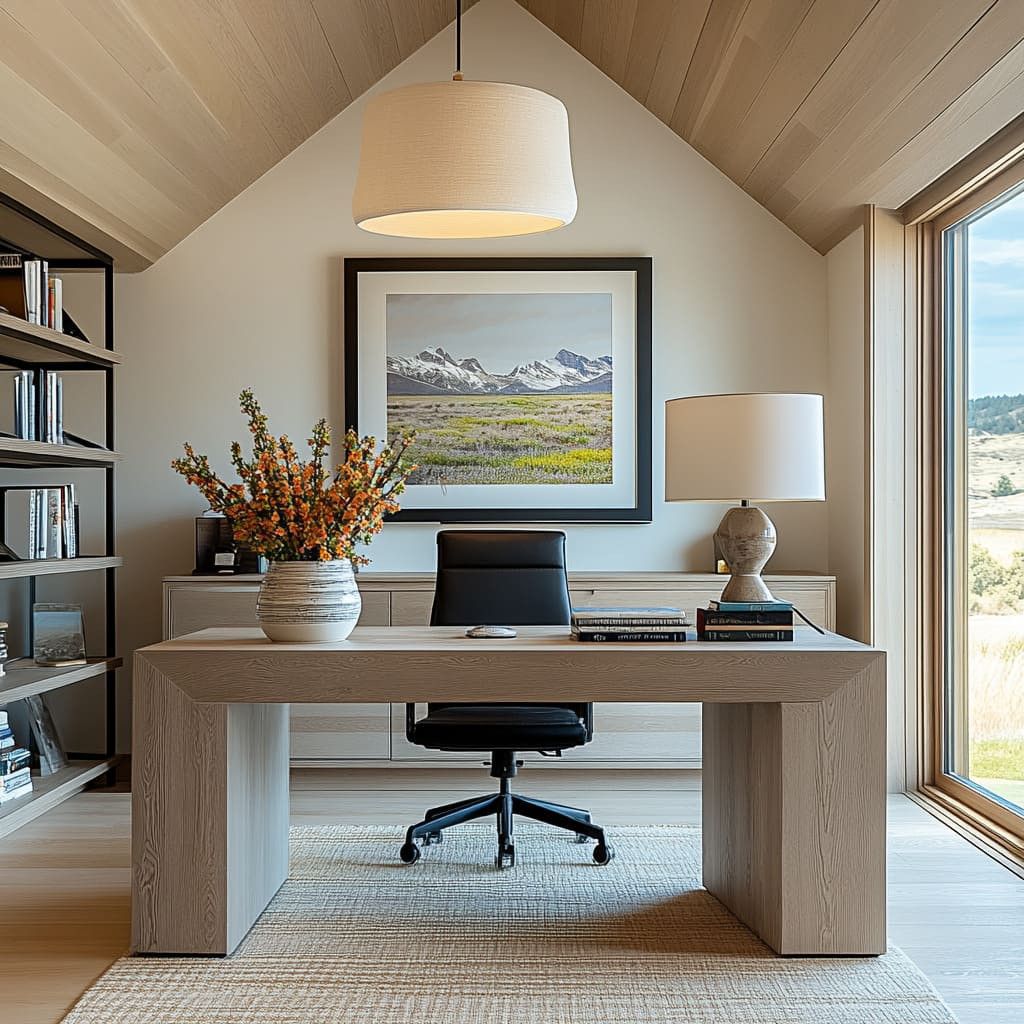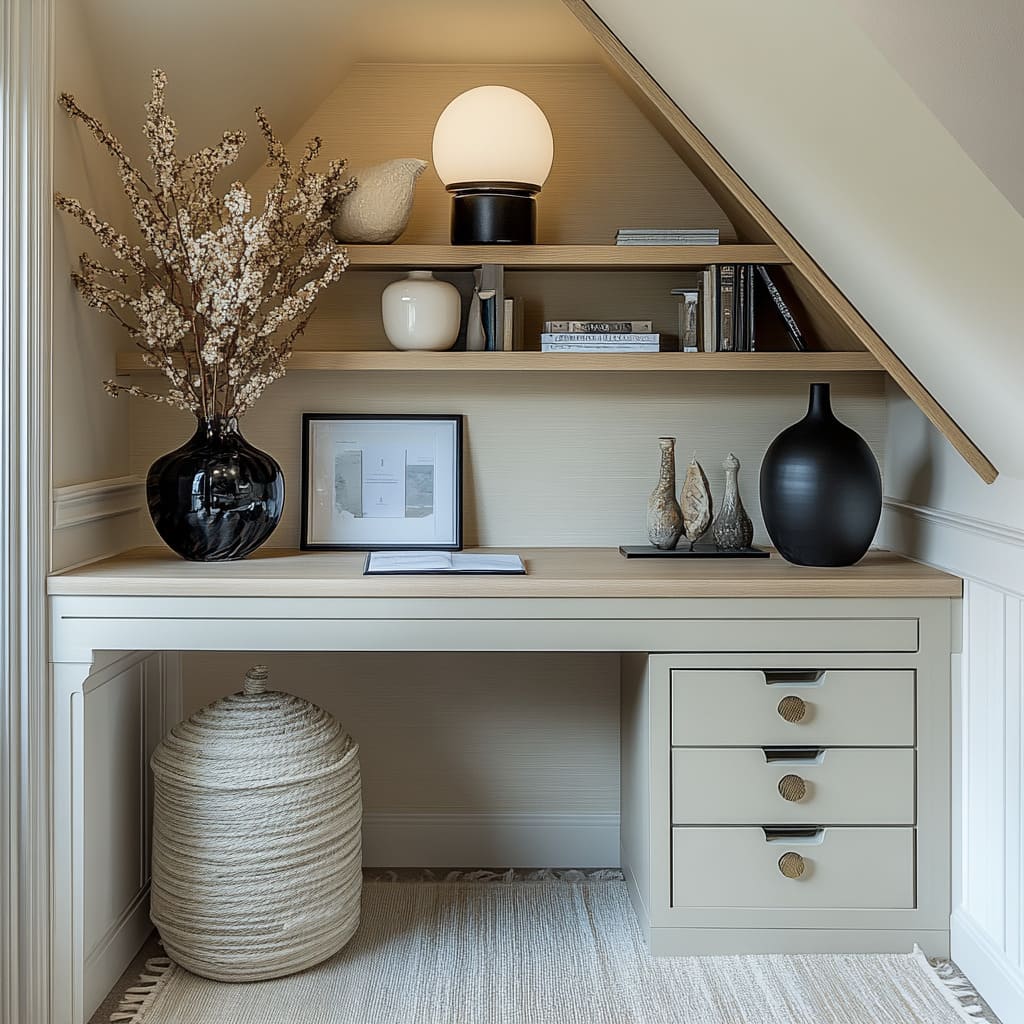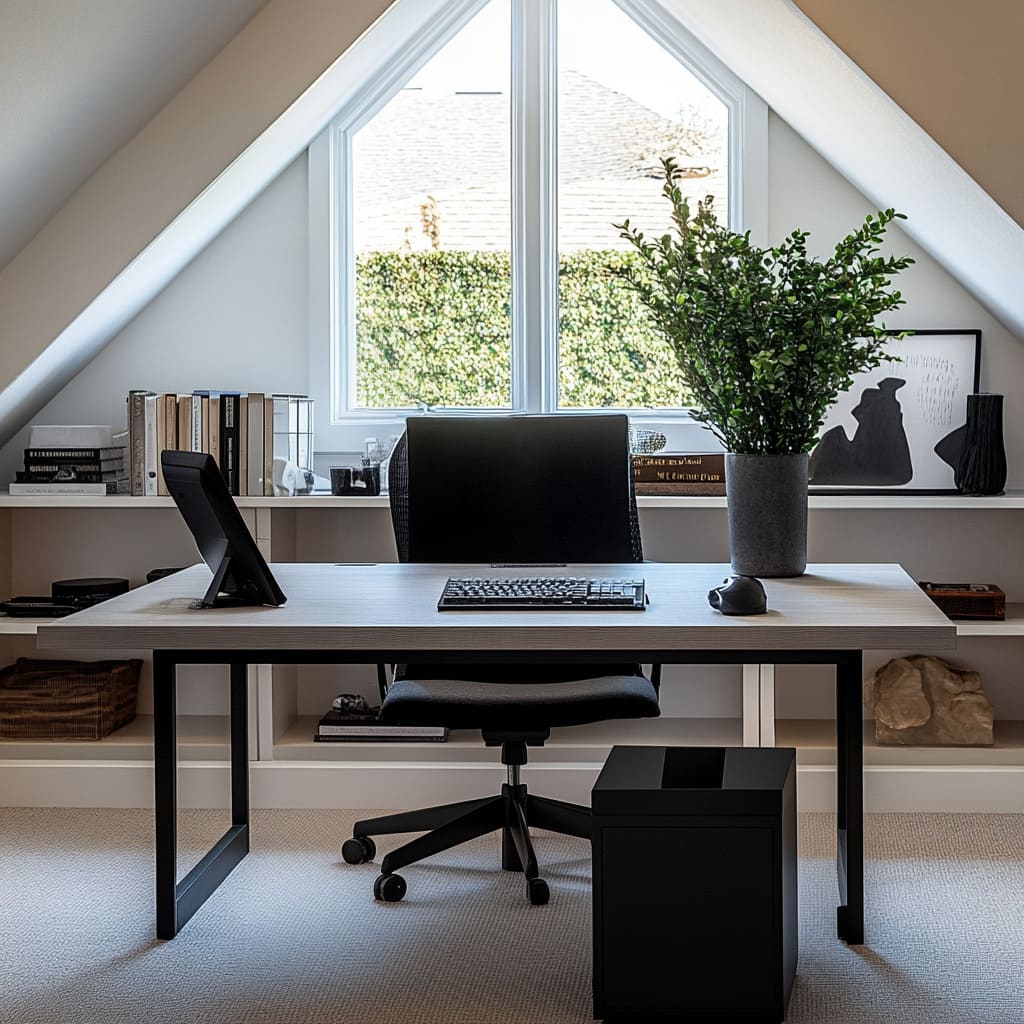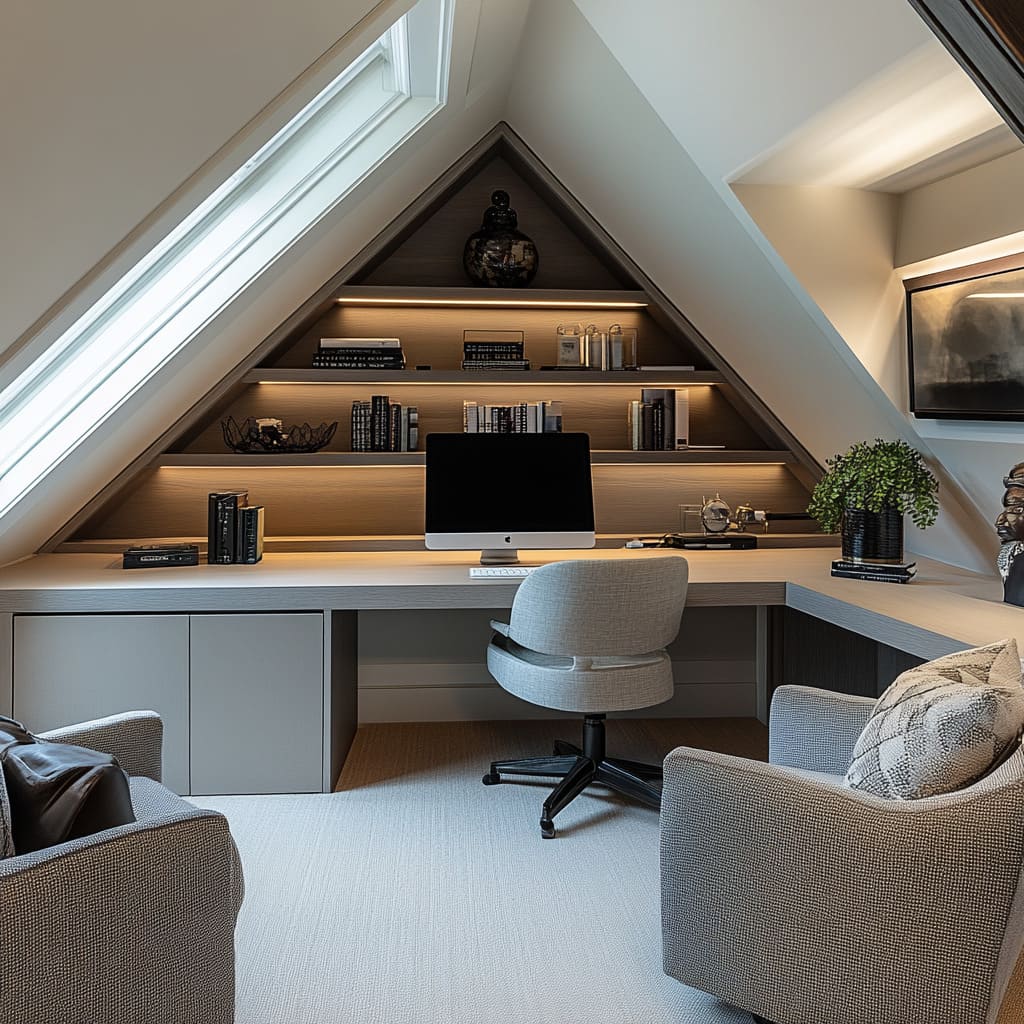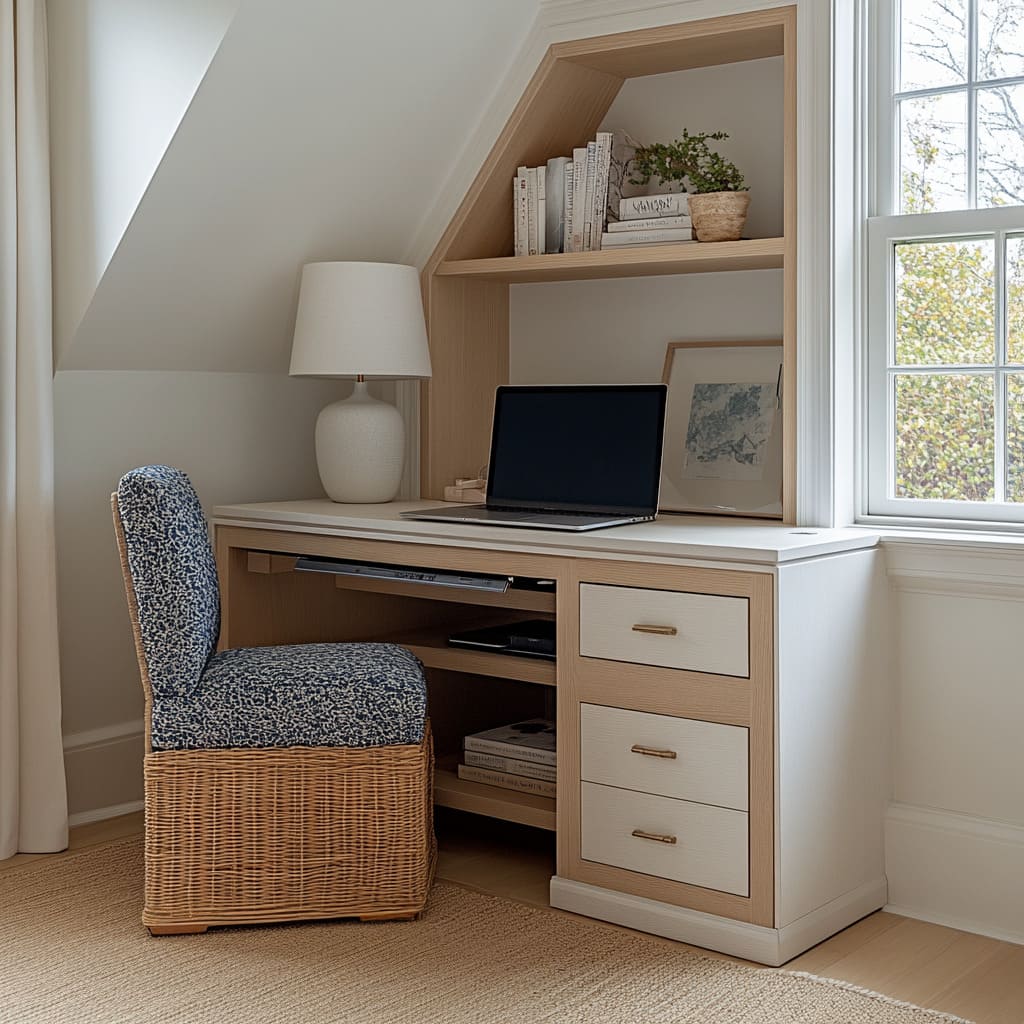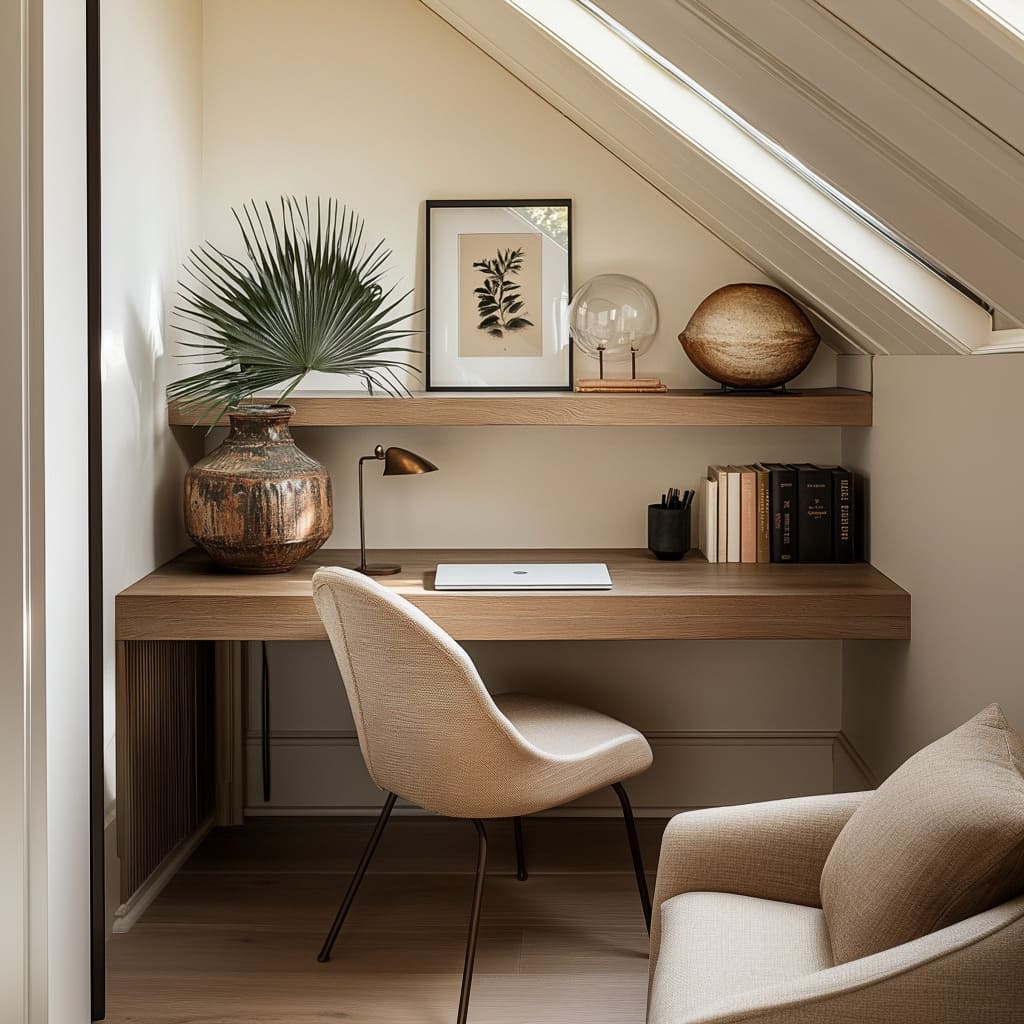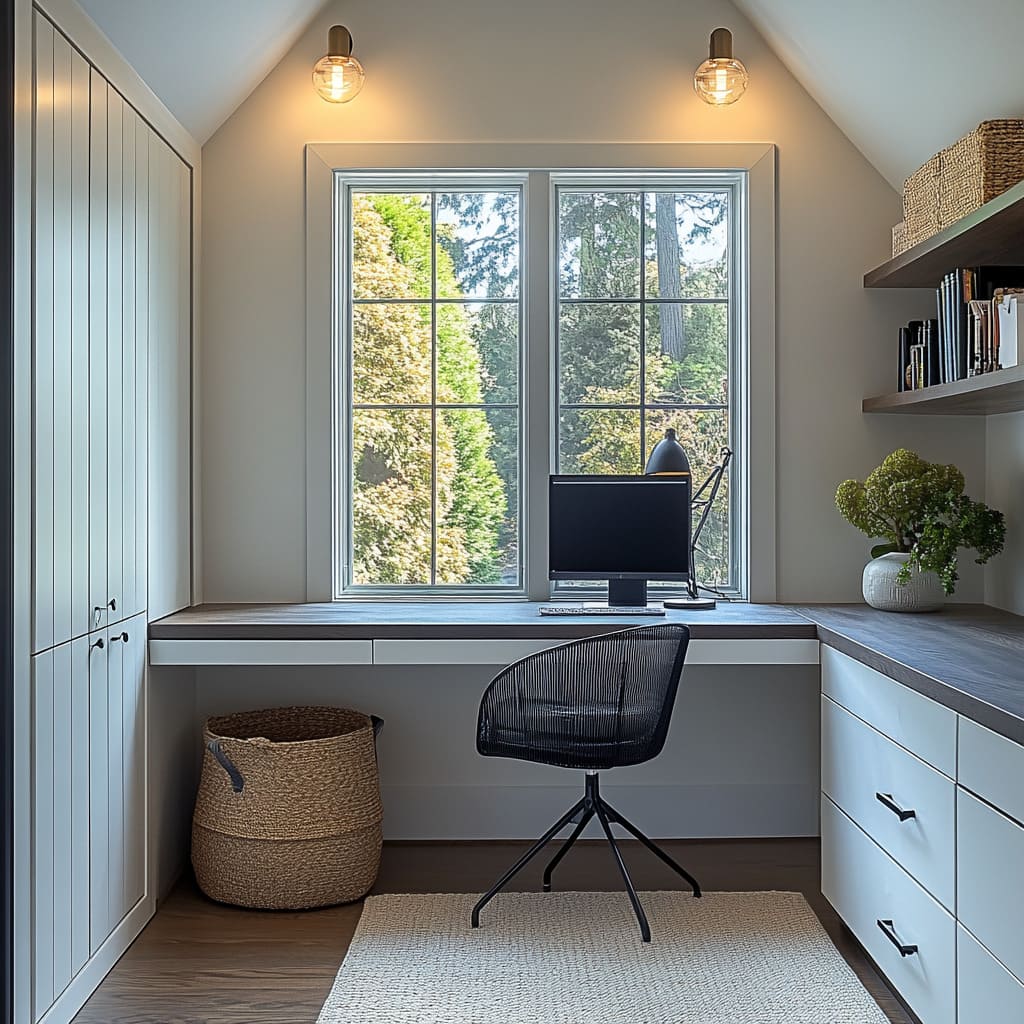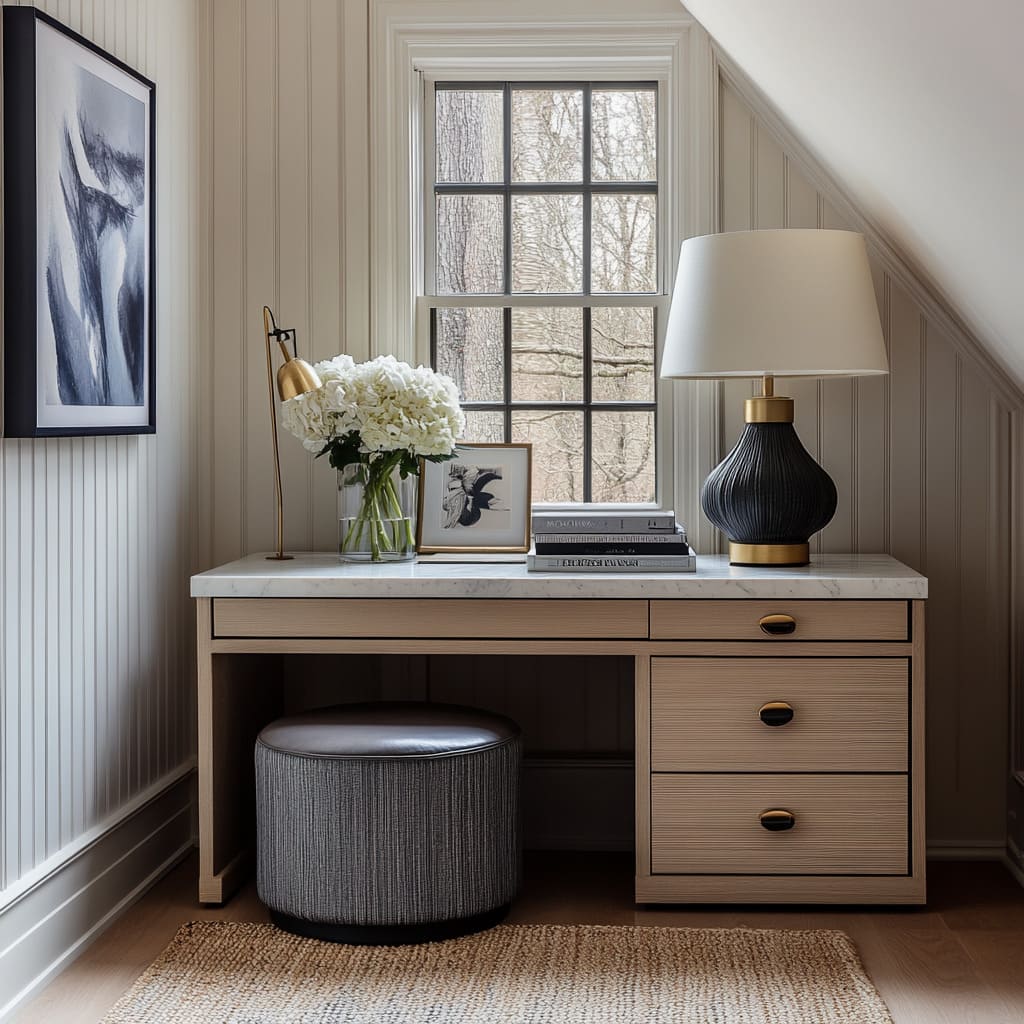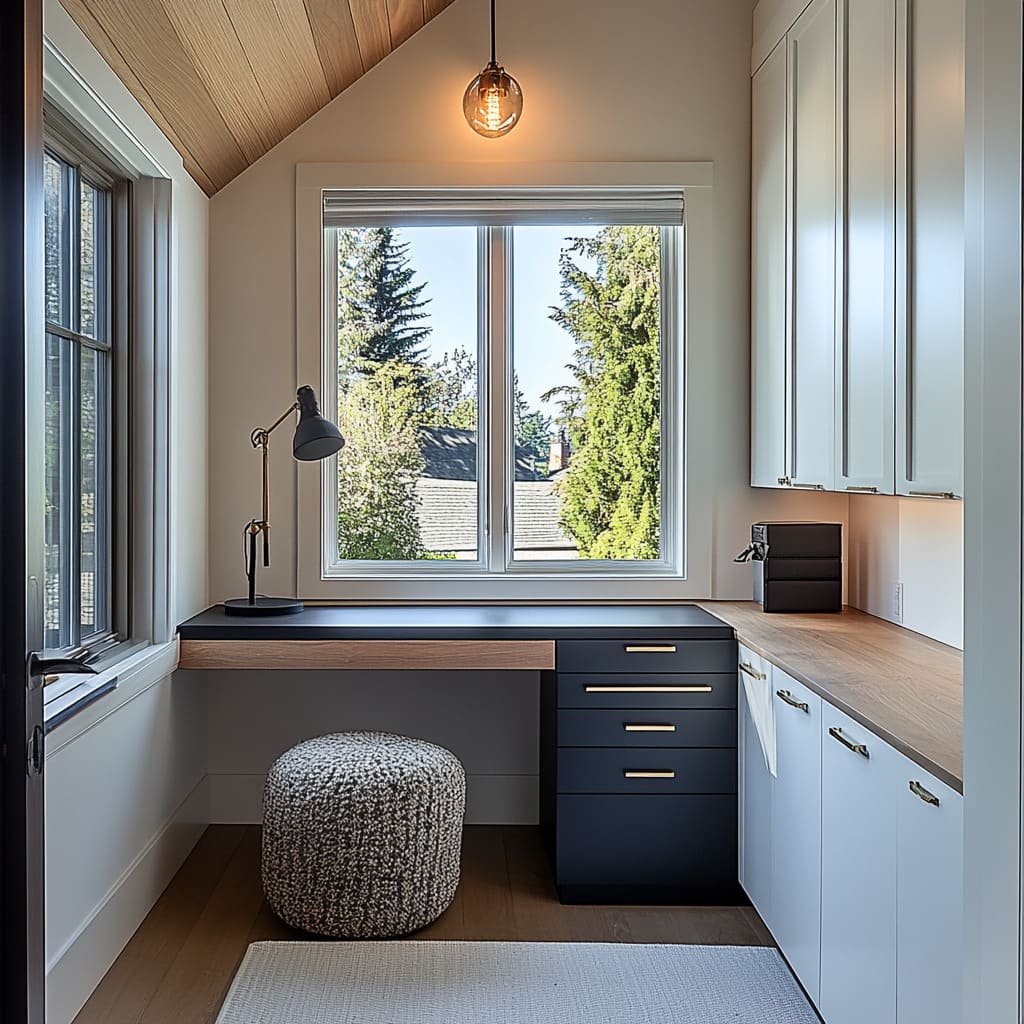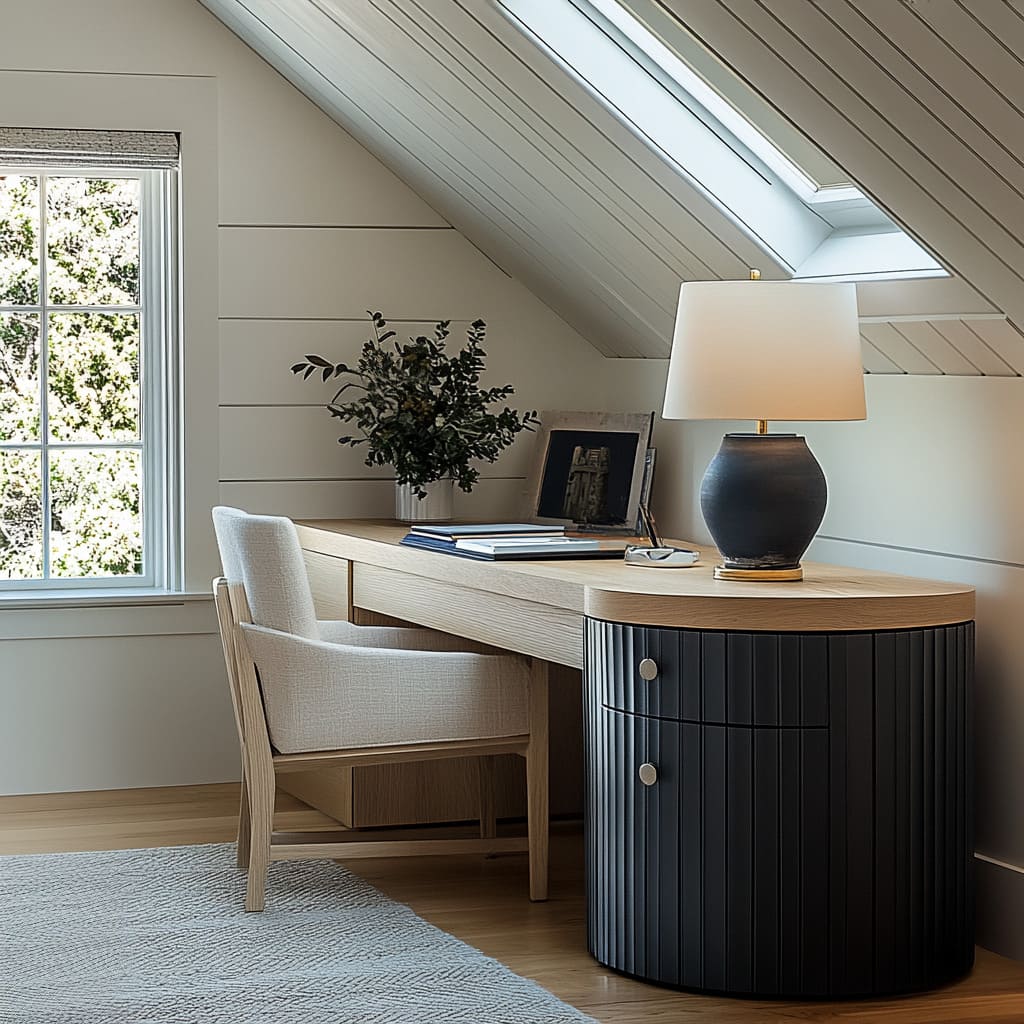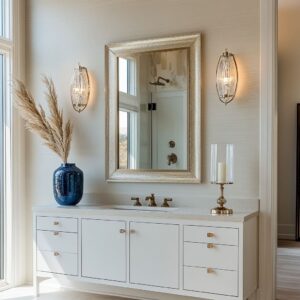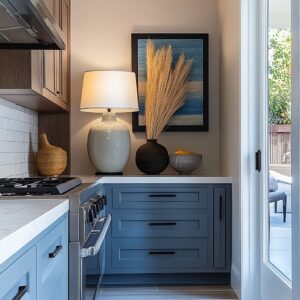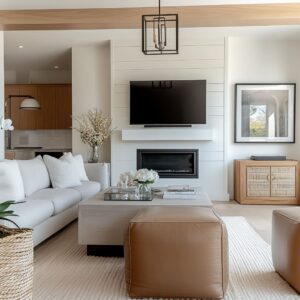Creating a home office that feels inspiring, practical, and uniquely yours is no small task. With so many possibilities for style, layout, and decor, it’s all about striking the right balance between function and design.
Whether you’re transforming a quiet corner, a compact attic space, or an entire room, thoughtful choices can make your workspace a place where productivity and comfort meet seamlessly.
This guide dives into everything you need to know about designing a standout home office, from blending styles that reflect your personality to making the most of your room’s architecture. You’ll find insights on maximizing storage, incorporating natural elements, and crafting a layout that works for your needs—all while keeping things stylish and inviting.
Whether you’re in a suburban house or an urban apartment, the ideas here are designed to help you reimagine what a home office can be. By exploring examples and techniques from a variety of design styles, this article will help you turn constraints like sloped ceilings or small spaces into standout features.
If you’re looking for inspiration to create a workspace that feels as good as it looks, you’re in the right place. Let’s start transforming those ideas into a home office that works hard and looks even better!
How to Mix Styles for Striking Home Office Design
Creating a standout home office involves blending different styles in ways that are visually compelling and functionally sound. Many of the designs observed here draw heavily from contemporary and modern aesthetics, enhanced by subtle yet deliberate touches from other design traditions.
This thoughtful mixing of styles brings personality to each space while maintaining a harmonious and purposeful environment.
Contemporary Foundations
At the heart of these designs is a contemporary foundation, characterized by clean lines, minimal ornamentation, and a clear focus on utility. Custom-built desks and shelving units are often employed, making the most of available space, particularly in rooms with sloped ceilings or other architectural quirks.
These tailored solutions seamlessly align with the room’s structure, ensuring every square inch serves a purpose. The simplicity of these elements creates a blank canvas that allows additional stylistic layers to shine without overwhelming the space.
Adding Rustic and Coastal Warmth
To counterbalance the precision of contemporary design, many spaces incorporate rustic and coastal influences. Materials like wicker, rattan, and natural wood finishes bring warmth and texture, transforming sterile corners into inviting work environments.
Chairs with woven backs, wooden desktops, or accents like rope baskets and linen curtains soften the visual impact of clean lines. This approach is particularly effective for small home office ideas, as it adds depth and charm without introducing clutter.
The natural tones in these elements often echo the outdoors, making the workspace feel grounded and calming.
A Touch of Mid-Century Modern
Mid-century modern pieces inject a hint of timeless sophistication into these offices. Think tapered chair legs, sleek wooden surfaces, and retro-inspired lamps.
These features add character and break the monotony of strictly modern elements. By layering in pieces with curved edges or vintage finishes, these designs achieve a striking balance of old and new.
For example, a minimalist desk might be paired with a chair featuring iconic mid-century contours, creating a focal point that feels intentional and polished.
Bohemian Accents to Loosen the Structure
Woven rugs, organic textiles, and free-spirited decor offer a playful contrast to the otherwise structured layouts. Bohemian influences are seen in subtle ways, like the inclusion of oversized plants, ceramic vases, or tactile wall hangings.
These elements bring in a sense of relaxation and informality, perfect for home offices that need to double as cozy retreats. By using soft textures and natural patterns, designers are able to imbue the space with personality while maintaining a cohesive look.
Key Takeaways for Style Mixing
The secret to achieving a striking home office lies in careful layering. Contemporary elements provide the structure, while rustic materials, mid-century details, and bohemian touches add variety and warmth.
Each of these styles brings something unique to the table, working together to create spaces that feel both personal and inspiring. Whether you’re designing from scratch or refreshing an existing setup, blending styles thoughtfully can result in a workspace that stands out for all the right reasons.
How Room Architecture & Layout Determines Design
Designing a functional and stylish workspace within unique architectural settings like attic home offices and dormer corners requires a thoughtful approach that embraces the room’s character. These spaces often come with their own set of challenges, such as sloped ceilings, tight layouts, and unconventional shapes.
However, with the right strategies, these challenges can be transformed into defining features that enhance the overall design.
Maximizing Potential Under Sloped Ceilings
Sloped ceilings are often seen as limitations, but they also offer a unique opportunity to create custom solutions that fit perfectly within the space. Built-in desks and shelving units are popular choices for their ability to contour to the room’s angles.
These bespoke installations take advantage of areas that might otherwise be wasted, such as low-clearance sections near the floor. For example, a floating desk tucked beneath a steep incline not only optimizes floor space but also adds a sleek, integrated feel that fits effortlessly into the surroundings.
Incorporating desk ideas for small spaces, like compact furniture or modular pieces, helps maintain functionality while preserving visual balance.
The Strategic Use of Natural Light
Natural light plays a pivotal role in these designs, with skylights, dormer windows, and generously sized framed windows serving as key architectural features. These elements not only brighten the space but also create an open and inviting atmosphere.
Designers often position workstations directly beneath skylights or adjacent to dormer windows to capitalize on the incoming light. This not only enhances focus and productivity but also highlights key design elements like natural wood finishes and soft textures.
In some cases, strategically placing mirrors amplifies the light and makes the room feel larger.
Compact Layouts That Don’t Sacrifice Functionality
In smaller home offices, especially those in attics or dormer corners, layouts are carefully curated to avoid overcrowding. The use of wall-mounted shelves and vertical storage systems keeps the floor area clear, maintaining a sense of openness.
Floating desks are another effective choice, as they combine practicality with a visually lightweight profile. These desks can be paired with slim storage cabinets or built-in drawers, ensuring every inch is used efficiently without overwhelming the space.
Additionally, layered textiles and soft rugs underfoot create a sense of comfort, further emphasizing the cozy nature of these compact layouts.
Defining Zones Within Multipurpose Rooms
For spaces that serve dual purposes—such as a home office combined with a guest room or reading nook—designers use subtle visual cues to delineate areas. Rugs, contrasting finishes, or variations in furniture materials can help distinguish the workspace from other parts of the room.
For instance, a textured area rug under the desk might signal the work zone, while a softer, plush rug in an adjacent seating area defines a more relaxed section. This zoning approach ensures the attic home office feels purposeful and separate, even within a shared environment.
These spaces prove that architectural quirks and spatial constraints can inspire rather than limit creativity. By embracing the unique features of attics and dormer rooms, designers can create stunning, functional environments that cater to both aesthetics and practicality.
Furniture Type & Style
Crafting a home office that merges beauty and utility starts with carefully chosen furniture, designed to suit the unique layout of small spaces. The featured designs showcase furniture that is both visually stunning and highly functional, reflecting an attention to detail that ensures these workspaces are comfortable, efficient, and perfectly integrated into their environments.
Custom-Built Desks
Custom-built desks are the cornerstone of these designs, transforming unconventional spaces into functional workstations. By tailoring each piece to fit unique room layouts, these desks make the most of limited square footage, particularly in areas with sloped ceilings or tight corners.
Materials like light oak, white oak, and walnut dominate the designs, with finishes that range from soft matte for understated elegance to a natural polish that highlights the wood grain. Many designs incorporate built-in desk ideas for small spaces, creating seamless solutions that feel as though they are part of the room’s architecture.
These desks are often paired with floating drawers or minimalist shelving, reinforcing the clean, cohesive aesthetic that defines these interiors.
Chair Designs for Form and Function
The choice of chairs varies widely across these designs, reflecting a mix of styles that balance form and function. Modern upholstered chairs, with clean lines and muted fabrics, are common in spaces emphasizing a contemporary look.
For a touch of rustic charm, wicker and rattan chairs are incorporated, blending natural textures with the warmth of wooden desks. Mid-century-inspired seating, with features like tapered legs and curved backrests, offers retro appeal while maintaining ergonomic comfort.
Designers consistently prioritize padded cushions and supportive frames to ensure long-term usability, underscoring the emphasis on creating a workspace that feels inviting and practical.
Integrated Storage Solutions
In these designs, storage is cleverly integrated into the furniture, blending functionality with aesthetic appeal. Desks are often equipped with drawers, open shelving, and even hidden compartments to maximize storage without cluttering the workspace.
Rattan inlays and recessed handles add visual interest, providing texture while maintaining a streamlined profile. This is particularly useful in small office design ideas, where every detail counts in creating a harmonious and uncluttered environment.
Vertical storage elements, such as tall bookshelves or wall-mounted cabinets, complement the desks, ensuring that essentials are within easy reach while keeping the floor area clear.
Compact but Effective Design Principles
For spaces where size is a limiting factor, small office desk solutions are key to maintaining both functionality and style. Narrow desks with slim profiles allow for efficient use of space, while wall-mounted desks or foldable designs provide options for multipurpose rooms.
Additionally, thoughtful pairings of contrasting materials—such as wood with metal accents or natural fibers with sleek laminates—create depth and personality within the room. These combinations ensure that small spaces feel both dynamic and personalized, catering to the user’s practical needs without sacrificing character.
Through a thoughtful mix of materials, customized features, and adaptable design solutions, these home office interiors demonstrate how furniture can elevate even the smallest of workspaces. Whether the goal is to create a professional setting or a cozy retreat, these designs highlight the importance of choosing pieces that enhance both functionality and aesthetic harmony.
Small Office Decor Ideas
When it comes to creating a stylish and functional home office, decor plays a critical role in transforming a purely utilitarian workspace into a visually captivating and comfortable environment. From subtle touches to bold accents, the decor choices in these interiors are carefully curated to enhance both aesthetics and practicality, making them ideal examples of small office decor ideas that inspire.
Artful Vases and Greenery
Decorative vases take center stage in these home offices, adding a sense of depth and sophistication. Ceramic, terracotta, and glass vases in varied shapes, finishes, and sizes offer both subtlety and character.
While some stand as sculptural pieces, others hold lush greenery or dried botanical arrangements. The addition of plants introduces a refreshing, organic quality, balancing the room’s structured layout.
These accents are often strategically placed on desks, shelves, or side tables, creating a harmonious interplay between functionality and style. The result is an inviting workspace that feels alive and personal.
Lighting with Character
Lighting choices are as functional as they are stylish, enhancing the overall ambiance of the room. Table lamps with textured bases—crafted from materials like ceramic, wood, or stone—are paired with linen shades that cast a warm and diffused glow.
These lamps provide a cozy yet practical light source, perfect for focused tasks or soft evening lighting. Pendant lights made from materials such as rattan, metal, or woven textiles bring an artistic and sculptural element to the space.
Their overhead placement not only maximizes desk space but also highlights key areas, proving invaluable when decorating small office space.
Artwork and Wall Accents
The addition of carefully chosen artwork contributes a personal touch while maintaining a clean and uncluttered feel. Framed prints, abstract pieces, and even mirrors are used sparingly, ensuring that visual interest does not overwhelm the room’s functional purpose.
These pieces are often aligned with the desk or situated on a focal wall, creating a point of interest without disrupting the room’s flow. For a minimalist yet intentional look, smaller framed art pieces are layered on shelves or leaned against walls, adding flexibility and charm.
Soft Textures and Layers
Textiles and woven accents bring warmth and depth to these small office designs. Rugs in neutral tones or with subtle patterns define work zones and add a layer of coziness to the overall decor.
These soft furnishings are paired with woven baskets that double as storage and decor, keeping clutter at bay while contributing to the natural, cohesive aesthetic. Throw pillows with muted tones or textured fabrics further enhance comfort, especially when paired with upholstered chairs or seating nooks, ensuring that even small spaces exude a sense of calm and comfort.
The decor in these home offices shows how thoughtfully selected elements can completely transform a workspace. Whether through a single statement vase, the glow of a textured lamp, or the grounding presence of a well-placed rug, these ideas serve as a guide for creating workspaces that are not only functional but also a joy to spend time in.
The combination of artful accents and practical solutions makes these designs a masterclass in balancing efficiency with style.
Main Trends To Be Aware Of
Home offices are undergoing a thoughtful transformation that emphasizes natural elements, multifunctional layouts, and designs that prioritize wellness. Whether you’re setting up a corner workspace or considering attic office ideas, staying aligned with these key trends will ensure your space is not only visually engaging but also highly functional.
The Rise of Natural Materials
Natural materials have become a cornerstone of modern design, and this trend is evident across the interiors discussed. Wood dominates in the form of light oak desks, built-in shelves, and flooring, offering a timeless and grounding quality.
Meanwhile, rattan and natural fibers such as jute appear in chairs, storage baskets, and rugs, adding texture and an organic feel to the spaces. The choice of these materials reflects a broader commitment to sustainable living, as they harmonize effortlessly with both minimalist and layered decor styles.
The inclusion of handcrafted elements also enhances the authenticity of each design, making them a popular feature in small home office design projects.
Neutral Palettes Enhanced by Bold Accents
While beige, white, and soft gray form the backbone of many home office interiors, strategically placed pops of color add vibrancy without disrupting the serene aesthetic. Accents like mustard yellow vases, navy throw pillows, or even greenery bring life to these otherwise neutral rooms.
The balance ensures the space remains calming for productivity while featuring focal points that capture attention. These colors often emerge in subtle decor elements, allowing homeowners to refresh the look seasonally without significant redesign efforts.
This approach also aligns well with smaller spaces, where excessive color might overwhelm the overall layout.
Multifunctional Designs for Urban Living
As urban homes continue to embrace compact layouts, multifunctionality is a defining trend. Desks often double as storage solutions with built-in drawers or shelving, making the most of every square inch.
For instance, floating desks paired with wall-mounted shelves provide vertical storage while leaving the floor area open, promoting a sense of spaciousness. Additionally, flexible layouts ensure that home offices can seamlessly integrate with shared or multipurpose rooms.
These thoughtful designs not only enhance utility but also reflect the broader movement toward creating smarter living environments, making them ideal for people seeking practical small home office design solutions.
Biophilic Design in Focus
The integration of biophilic design principles is a standout trend that transforms these offices into spaces that nurture well-being. From leafy green plants placed in textured vases to the clever use of natural light through skylights or dormer windows, the connection to nature takes center stage.
Greenery not only purifies the air but also introduces an element of liveliness, while expansive windows ensure that the interiors are flooded with natural light. These features are especially notable in attic layouts, where sloped ceilings can feel enclosed without strategic lighting or decor.
By prioritizing light and nature, these spaces inspire a sense of calm and focus, demonstrating the timeless appeal of attic office ideas. By combining natural materials, thoughtful palettes, multifunctionality, and biophilic elements, these home offices are not only stylish but also adaptable to modern lifestyles.
They showcase how timeless design principles can be applied with a fresh, contemporary twist, ensuring that your workspace meets both aesthetic and practical needs.
Design Principles and Ideas To Follow
Creating a cohesive and inviting home office involves more than just choosing stylish furniture and decor. It’s about implementing fundamental design principles that elevate functionality and aesthetics.
Whether for a small office interior design or a larger workspace, these principles form the backbone of thoughtful interiors.
Balance: A Harmony of Elements
Balance is a cornerstone of any successful interior. These home offices achieve it by blending structured lines with softer elements, creating spaces that feel grounded yet welcoming.
Clean, angular furniture like rectangular desks and streamlined shelving is softened by textured rugs, plush chairs, and natural elements like potted plants or woven baskets. The interplay of materials, from smooth matte surfaces to cozy fabric upholstery, ensures the spaces are neither too rigid nor overly casual.
This sense of balance extends to color choices as well, with neutral tones forming the foundation while subtle accents add warmth and character.
Proportion: Making the Most of Every Inch
Proportion is particularly critical in designs that accommodate unique architectural features like sloped ceilings or compact layouts. Custom-built desks and shelving systems fit seamlessly into these irregular spaces, ensuring that no corner is left unused.
For example, desks crafted to align with dormer windows or shelving that follows the incline of a ceiling enhance usability without feeling cramped. These proportions not only maximize functionality but also contribute to the aesthetic flow of the room, avoiding the cluttered appearance that ill-fitting furniture can create.
This is particularly evident in built-in furniture tailored to the specific dimensions of small office interior design, where efficient use of space is paramount.
Contrast: A Visual Dialogue
Contrast is a subtle yet powerful tool used to draw the eye and add dimension. Light walls are paired with darker-toned desks, while glossy decor pieces like ceramic vases or metallic lamp bases stand out against matte finishes.
This interplay of light and dark, smooth and textured, keeps the design dynamic and engaging. Even smaller elements, like woven rattan storage drawers against painted cabinetry, illustrate how contrast creates depth without overwhelming the space.
These contrasts are further emphasized by natural light, highlighting the balance between functional and decorative elements.
Layering: Adding Depth and Character
Layering is an essential technique that adds richness to a design. These home offices skillfully combine materials, textures, and decor to create spaces that feel sophisticated and multidimensional.
A wooden desk might be complemented by a soft, woven rug underneath, while fabric chairs and cushions add another tactile layer. The use of decor, such as stacked books, framed artwork, or sculptural accents, contributes to the layered look without making the space feel crowded.
This careful layering is especially important in smaller offices, where every element needs to contribute to the overall design without overwhelming the room. By following these principles—balancing contrasting elements, tailoring furniture proportions, and incorporating layered textures—these home offices transform into spaces that are as visually appealing as they are functional.
Whether you’re starting with a blank slate or updating an existing setup, integrating these ideas ensures a design that’s practical, stylish, and timeless.
Useful Design Combinations
Home offices designed within unique architectural spaces often blend creativity and practicality to form environments that feel both stylish and efficient. By working with, rather than against, structural quirks like sloped ceilings and compact layouts, these designs showcase an innovative use of space, lighting, and decor.
Integration with Architecture
Rather than being a limitation, the sloped ceilings and dormer windows characteristic of many attic spaces are transformed into key design features. Dormer windows, in particular, become natural focal points, with desks thoughtfully placed beneath them to create framed work areas bathed in natural light.
Surrounding these desks, flanking shelves offer a cohesive look while providing practical storage for books, decor, or office necessities. These built-in arrangements not only utilize what might otherwise be dead space but also tie the furniture seamlessly into the room’s architecture.
This approach resonates with modern office design ideas for small spaces, where clever integration is essential to achieve both functionality and elegance.
Functional Aesthetic Fusion
Achieving balance between utility and style is a recurring theme in these designs. Functional items such as books and office supplies are incorporated into the decor, seamlessly blending the practical with the beautiful.
For instance, neatly stacked books are paired with decorative vases or sculptural objects to maintain a sense of order while injecting personality into the workspace. The result is a curated look that feels intentional rather than utilitarian.
Desks with integrated storage, such as drawers with rattan inlays or recessed handles, further contribute to the clean, organized aesthetic, making it easier to maintain an uncluttered workspace.
Dynamic Light Sources
Lighting plays a pivotal role in creating the perfect atmosphere for productivity and relaxation. A mix of natural and artificial light ensures functionality throughout the day and night.
Skylights and dormer windows allow ample daylight to flood the space, reducing the need for artificial lighting during work hours. At night, table lamps with textured bases and warm linen shades add ambiance, softening the sharper edges of the furniture.
Pendant lights or wall sconces often complement the design, serving as both practical fixtures and decorative accents. This thoughtful layering of light sources adds depth and highlights key areas of the room, further enhancing its usability and visual appeal.
Compact Elegance
In smaller home offices, maximizing floor space without compromising functionality is a priority. Floating desks, for example, offer a streamlined solution, appearing almost weightless while still providing a sturdy surface for work.
Minimalist shelves that extend vertically draw the eye upward, making the room feel taller and less confined. These elements combine to create the illusion of openness, even in tight quarters.
Paired with neutral color palettes and carefully chosen decor, this approach ensures the space feels light and airy while maintaining its practical purpose. These clever combinations exemplify how to approach the challenges of designing a home office with both style and functionality in mind.
By working with architectural quirks, embracing multifunctional elements, and employing lighting and layout strategies, these spaces demonstrate how thoughtful design can make even the smallest office feel inviting, efficient, and stylish.
How To Turn Constraints Into Features: Unlocking Small Office Potential
Designing small office spaces at home often requires a shift in perspective—what initially appears to be a limitation can become a defining feature. From slanted ceilings to challenging layouts, these spaces reveal how clever design principles and thoughtful choices can create both functionality and aesthetic appeal.
Layered Storage Systems
A layered approach to storage is a recurring theme in these designs, demonstrating how versatility and organization go hand in hand. Open shelving provides a space to showcase books, decor, and personal items, injecting personality into the workspace.
Closed drawers, often featuring subtle details like rattan inlays or recessed pulls, maintain a clean and minimalist appearance while concealing clutter. Decorative baskets—woven from natural fibers—serve as a functional and stylish solution for organizing smaller items, adding warmth and texture.
This blend of storage types ensures practicality without sacrificing visual harmony.
Accentuating Awkward Spaces
Rather than masking the quirks of attic spaces or small home offices, these designs embrace architectural nuances like alcoves, dormer windows, and slanted ceilings. A sloped ceiling is transformed into a cozy reading nook or an ideal spot for built-in shelving.
Alcoves are outfitted with desks that fit seamlessly into the space, making use of every inch. By working with these unique features, the designs highlight how small office ideas at home can turn seemingly awkward corners into standout elements that define the room’s character.
Blending Styles for Timelessness
A key takeaway from these designs is the importance of combining different styles to achieve a balanced, timeless look. Contemporary foundations, defined by clean lines and functional layouts, are elevated with accents from other design traditions.
Rustic touches, such as natural wood finishes and organic textures, soften the room’s structured edges. Bohemian elements like woven rugs and free-flowing arrangements add a relaxed, approachable quality, while mid-century furniture silhouettes and vintage lighting provide a subtle nod to the past.
This thoughtful fusion ensures the office feels current but not overly tied to fleeting trends.
Mindful Greenery Placement
The integration of plants is a subtle yet impactful feature in many of these designs. Greenery serves multiple purposes: softening the room’s sharp edges, adding a touch of vitality, and fostering a connection to nature.
The placement is always intentional—whether it’s a tall potted plant near a window to frame the view or a small succulent on a desk to introduce an organic element without cluttering the space. These natural touches enhance the workspace’s overall atmosphere, creating a balanced harmony between the built and natural environment.
Scalability of Designs
One of the most striking aspects of these spaces is their adaptability. Although tailored for compact layouts, the design principles—such as layering textures, blending styles, and strategically placing decor—can easily be scaled up to accommodate larger areas.
Whether working within a small attic or a spacious home office, these ideas prove to be flexible and versatile, demonstrating that good design transcends size. These strategies showcase how design ingenuity can transform challenges into opportunities, allowing even the smallest home offices to shine.
By combining layered storage, embracing architectural quirks, and blending diverse styles, these spaces achieve a perfect balance of form and function. With such thoughtful approaches, these designs stand as a testament to how small office interiors can deliver big impact.
Recommendations and Takeaways
Designing a functional and visually appealing home office goes beyond choosing the right furniture or decor—it’s about crafting a space that harmonizes style, practicality, and individuality. These recommendations provide actionable insights to achieve a workspace that feels both purposeful and inspiring.
Custom Designs for Unique Spaces
One of the standout elements in these home offices is the use of bespoke furniture and storage solutions. Custom-built desks, shelving, and cabinetry are tailored to fit the room’s specific dimensions, transforming even the most challenging spaces into functional work areas.
For example, desks integrated into alcoves or beneath sloped ceilings make the most of awkward layouts while maintaining a cohesive aesthetic. Incorporating small home office furniture that is customized ensures that every piece serves a dual purpose—enhancing functionality and contributing to the room’s overall design.
Neutral Foundations with Room for Expression
A neutral color palette forms the backbone of many designs, providing a versatile canvas for additional elements. Shades of beige, white, and soft gray create a calm and professional atmosphere, while allowing for accents like bold throw pillows, vibrant wall art, or colorful vases.
This approach ensures that seasonal updates or personal touches can be incorporated without disrupting the room’s balance. By keeping the foundational elements neutral, homeowners can easily adapt the space to evolving tastes or functional needs over time.
The Importance of Light
Lighting is a critical consideration for any home office, impacting both functionality and mood. Natural light is prioritized, with skylights, dormer windows, and large framed windows strategically placed to illuminate key areas like desks and shelving.
These natural light sources are complemented by warm, layered lighting solutions such as table lamps, pendant lights, and wall-mounted fixtures. The combination of natural and artificial light ensures a workspace that remains inviting and practical throughout the day, adapting seamlessly to different tasks and times.
Embracing Textural Variety
The use of varied materials is a hallmark of these designs, adding depth and interest to the spaces. Smooth wooden desks, textured rugs, woven baskets, and upholstered chairs create a multi-sensory experience that elevates the overall design.
This layering of textures prevents monotony and allows the room to feel dynamic and welcoming. Mixing natural materials like rattan, jute, and linen with sleek finishes like polished wood or metal accents creates a balance that feels both grounded and modern.
Biophilic Enhancements for Wellness
Greenery is not just a decor choice—it’s an essential part of creating a home office that promotes well-being. Plants placed on desks, in corners, or on shelving soften the room’s lines and bring a touch of nature indoors.
Beyond aesthetics, they improve air quality and introduce a sense of vitality to the space. Biophilic design principles are particularly effective in home offices, where a connection to nature can enhance focus, creativity, and overall mood.
Bringing It All Together
By combining custom furniture, neutral tones, thoughtful lighting, varied textures, and natural elements, these home offices demonstrate how to balance function with style. Whether designing from scratch or updating an existing space, these principles ensure a cohesive and adaptable environment that supports productivity and comfort.
The key is to approach each element with intention, ensuring that it contributes meaningfully to the space while reflecting the user’s personal needs and preferences.
